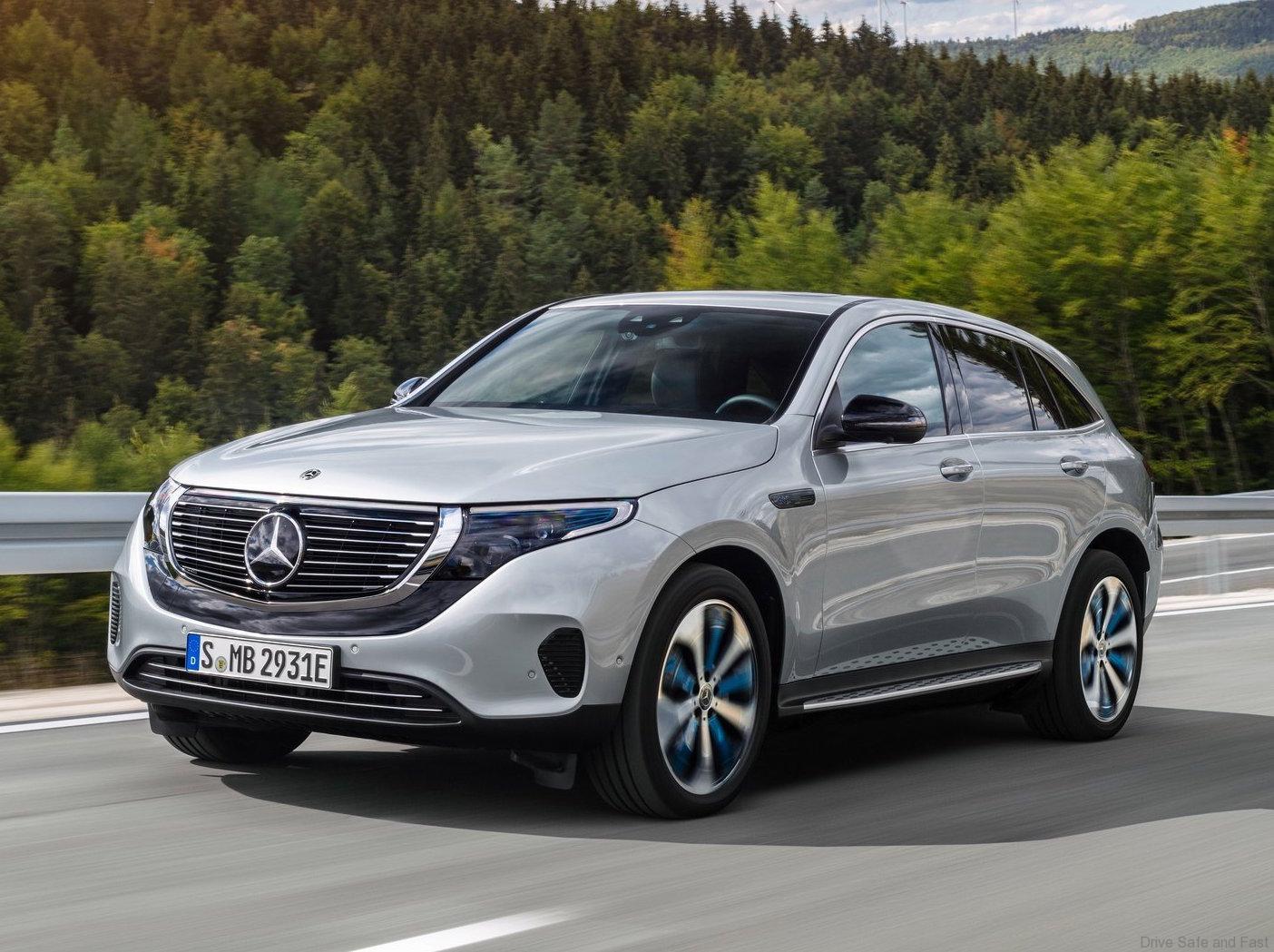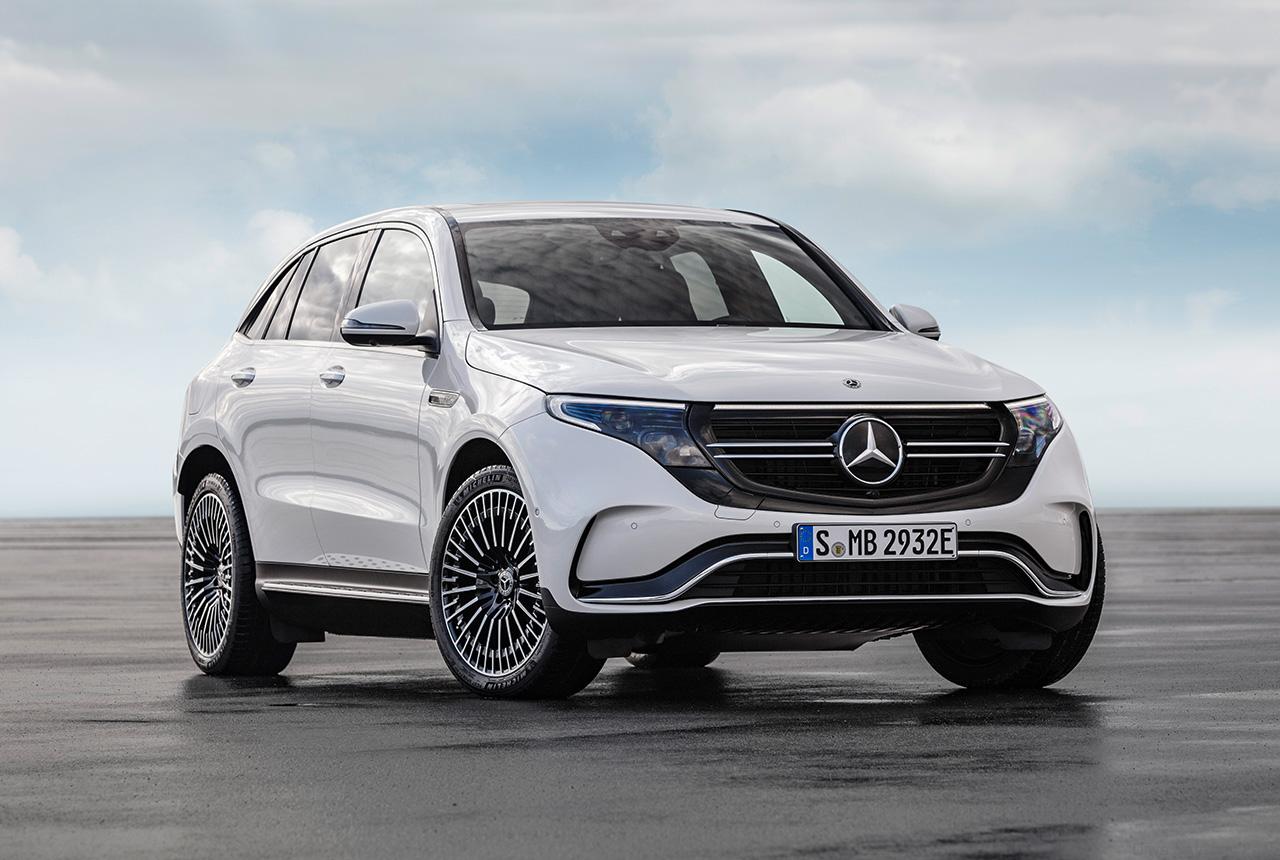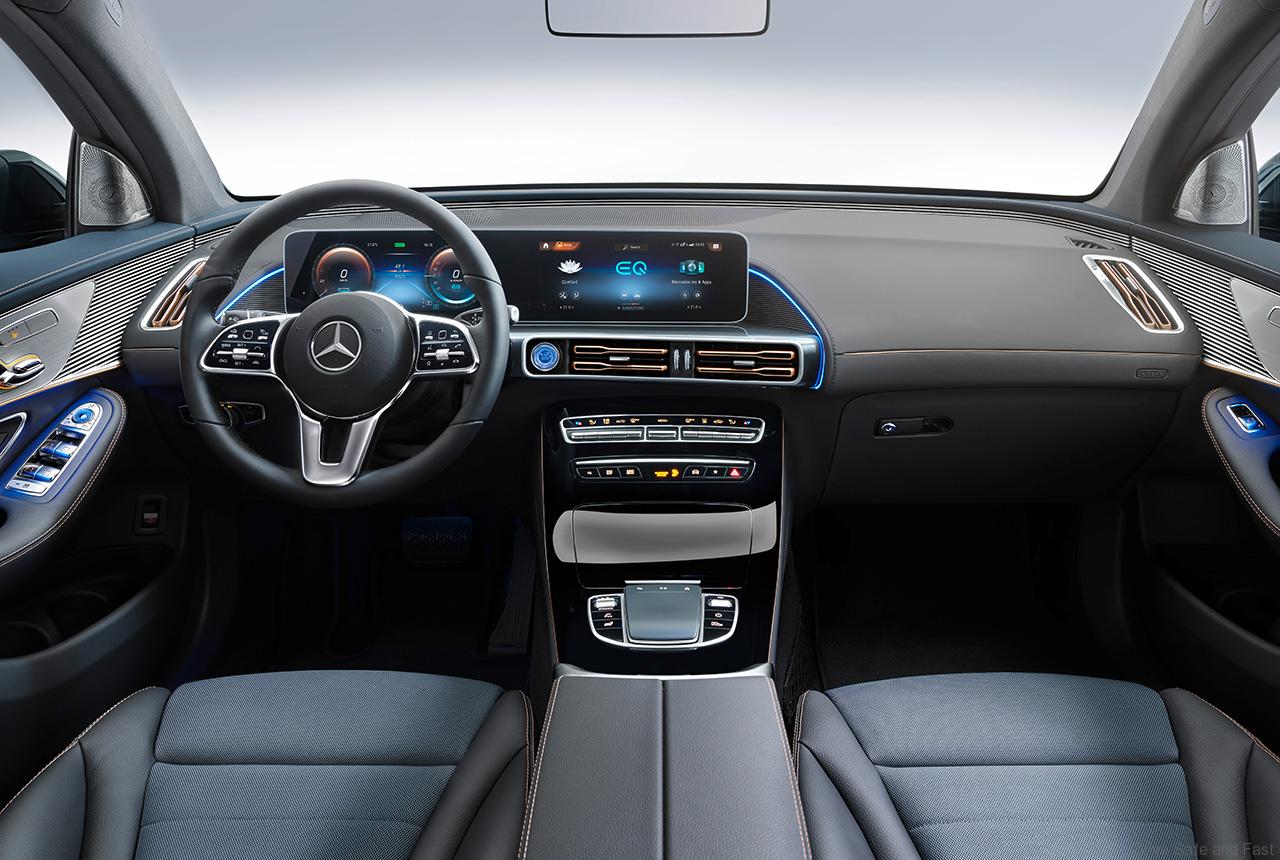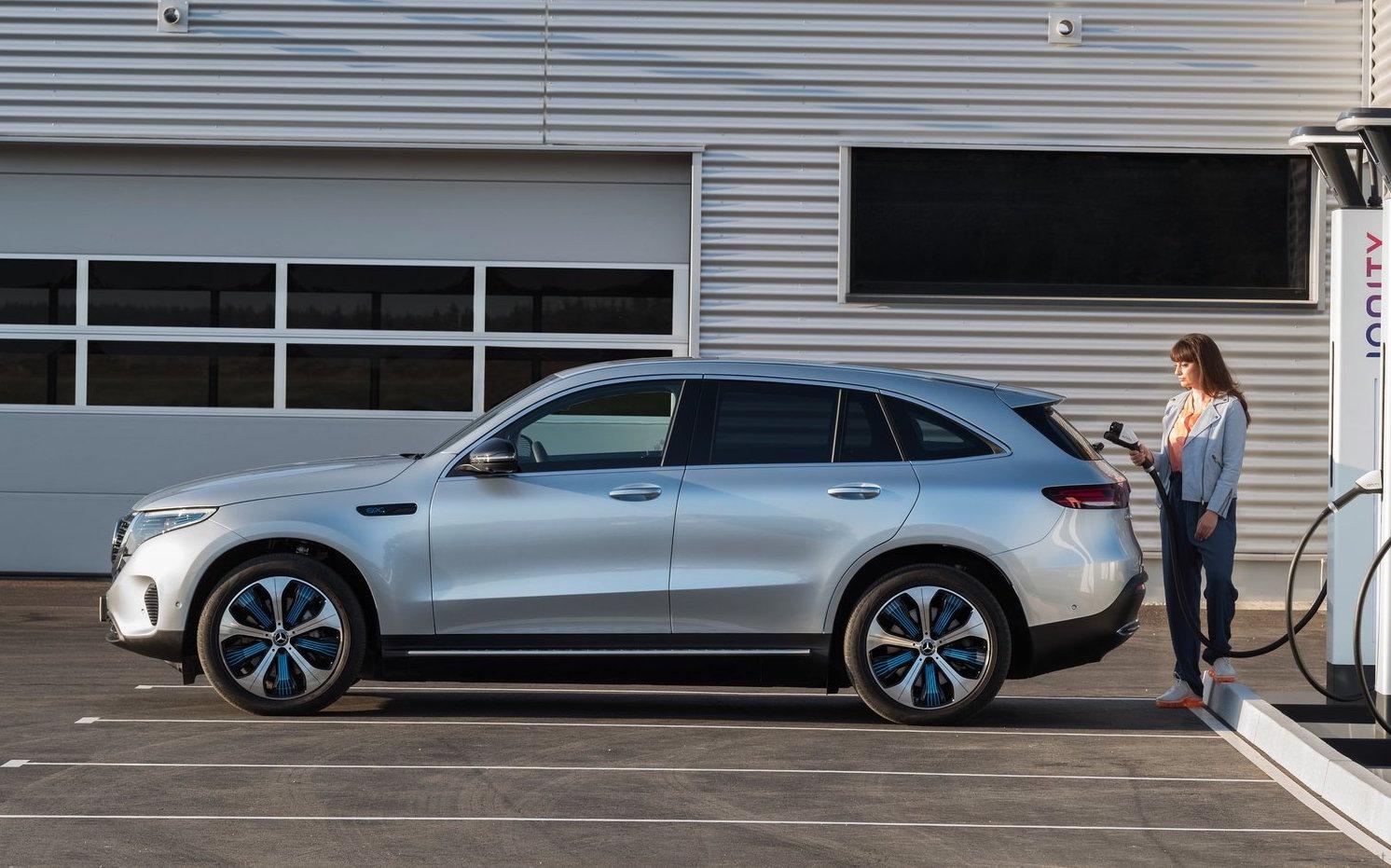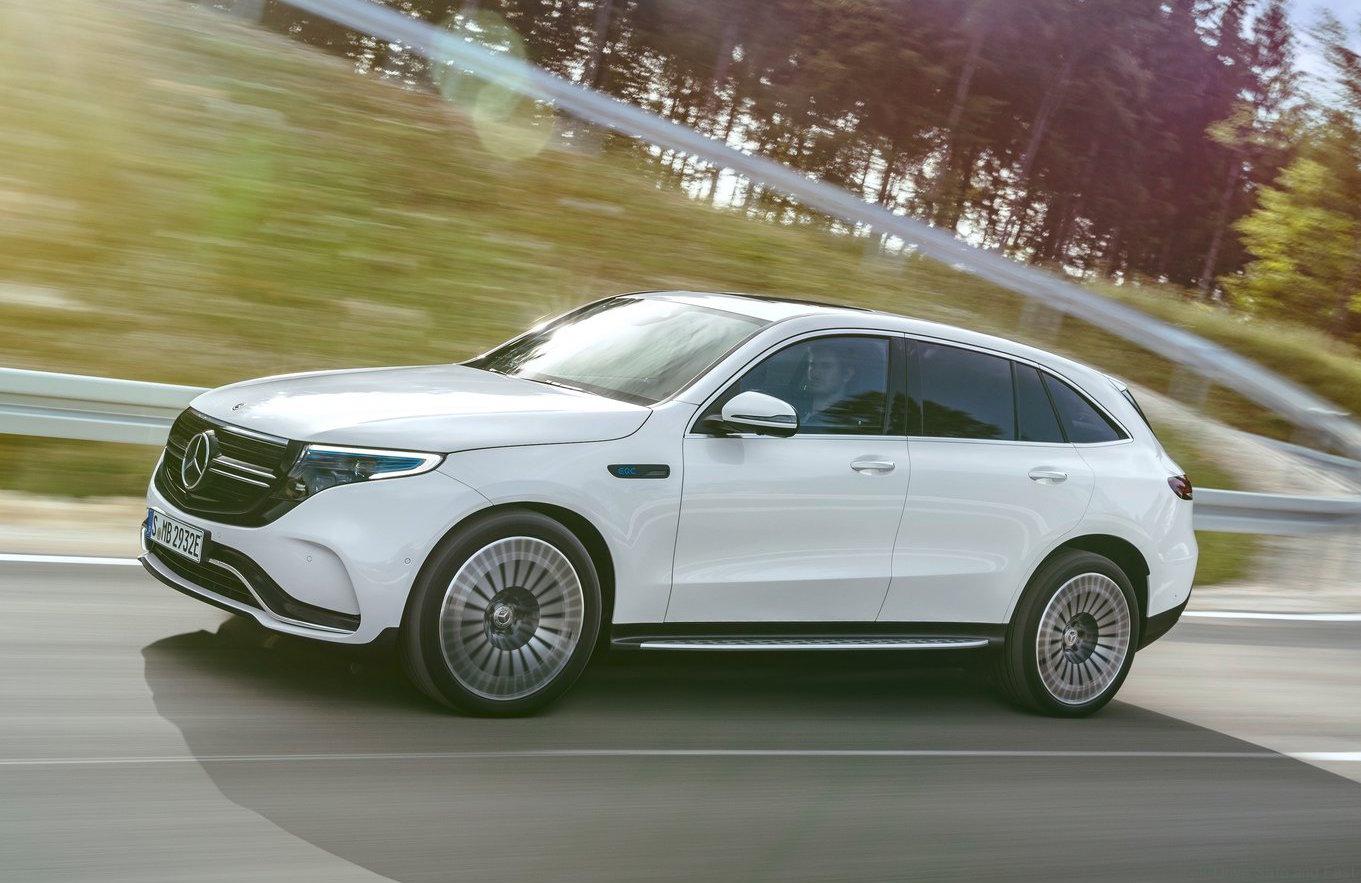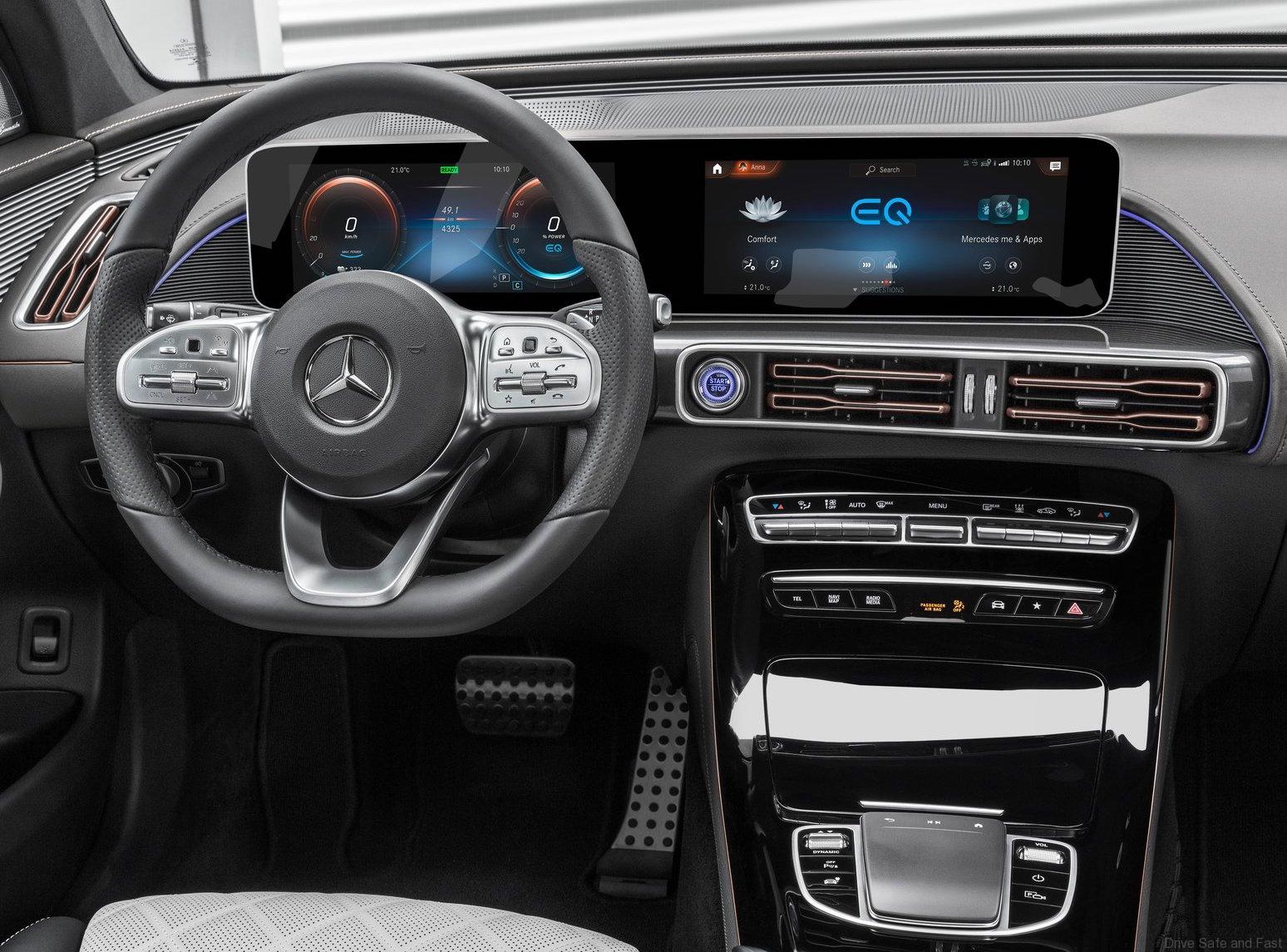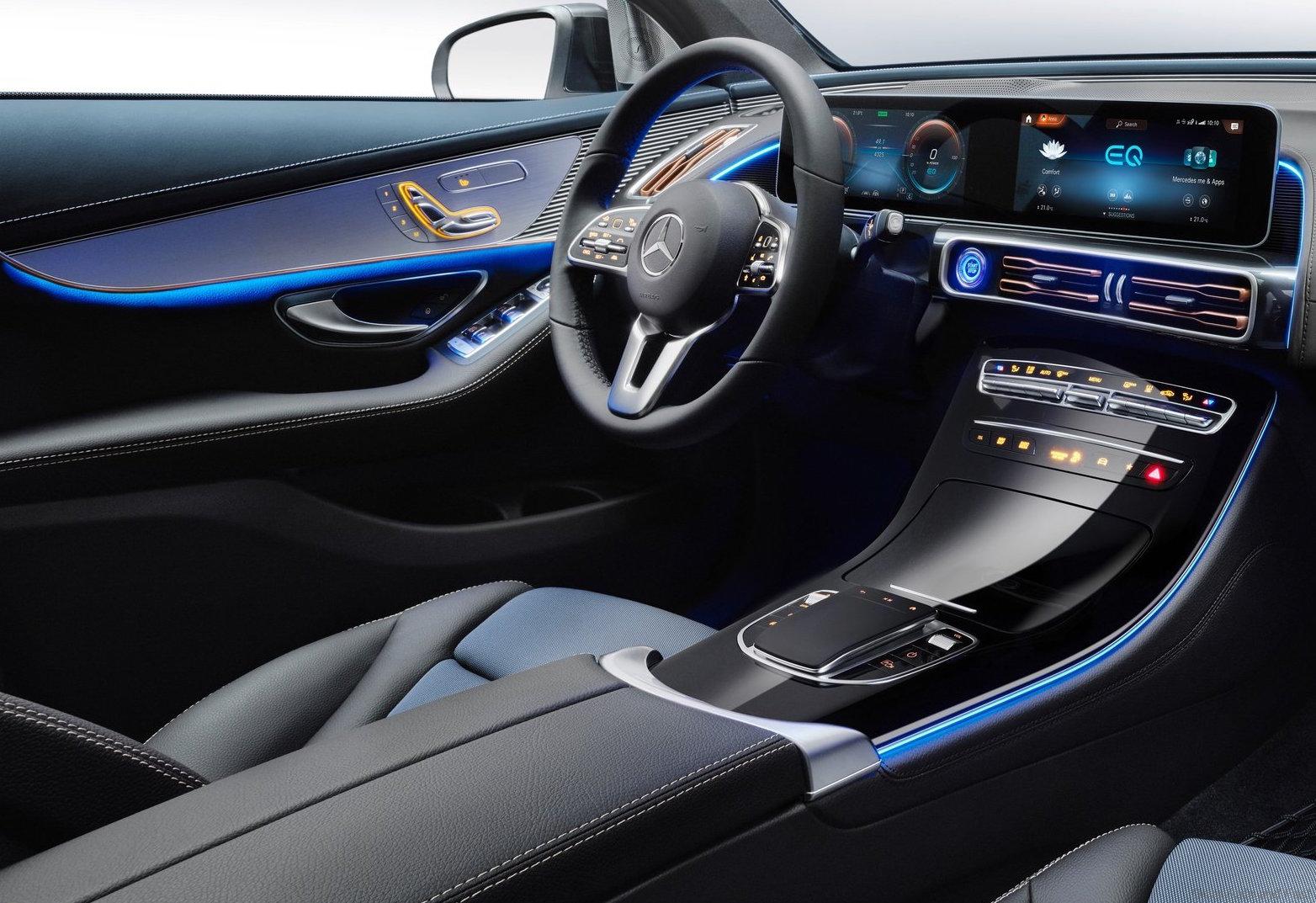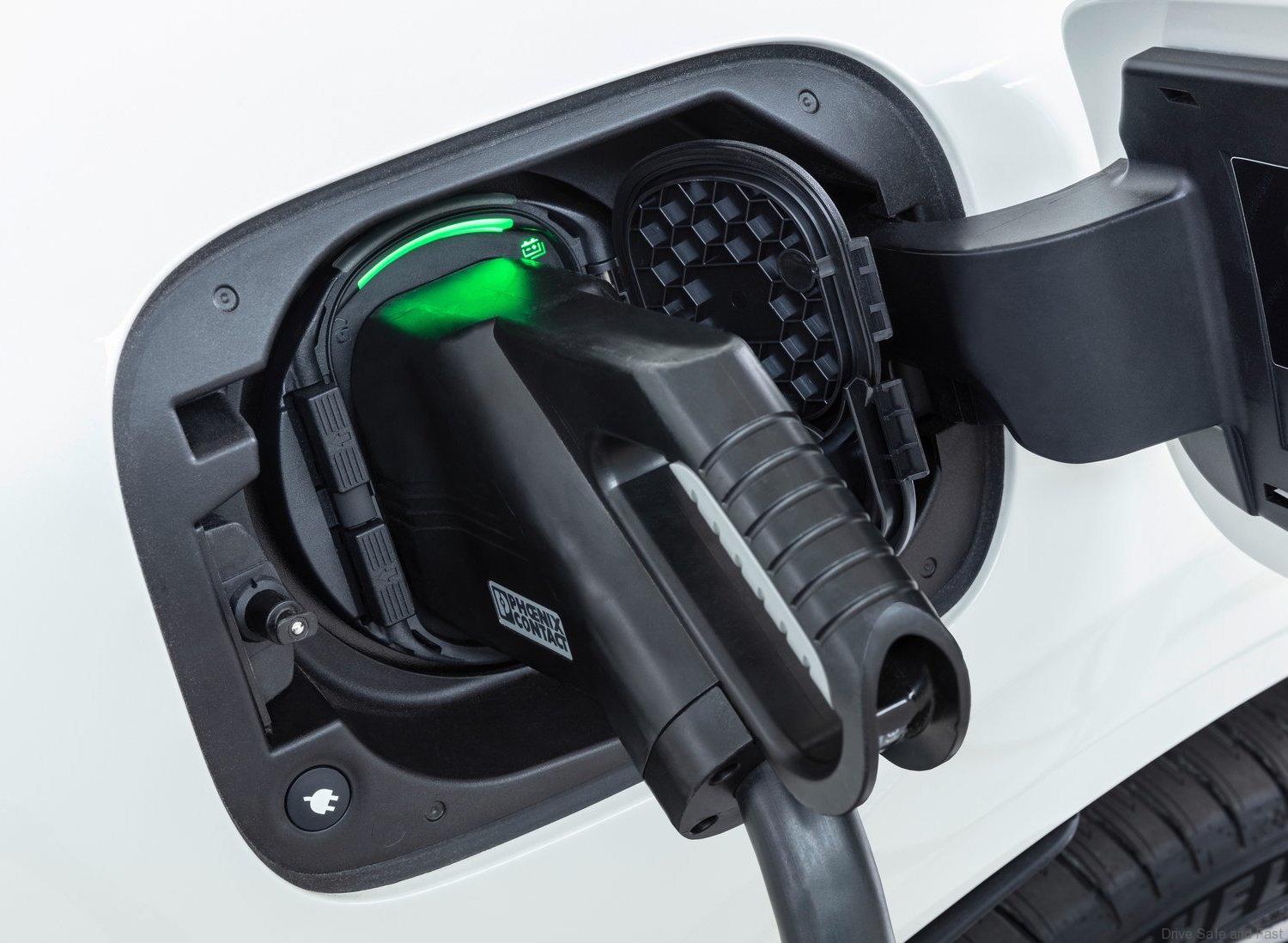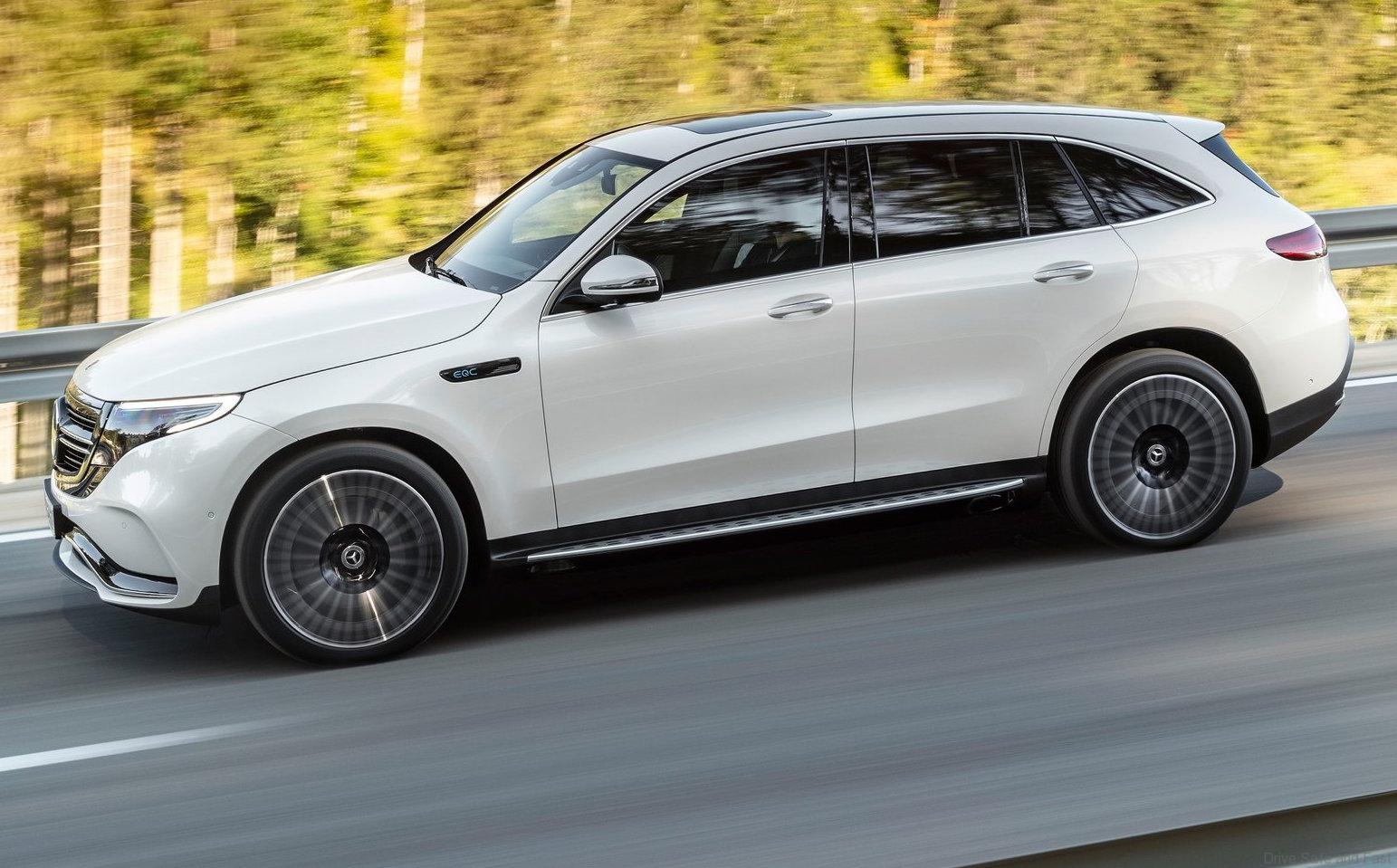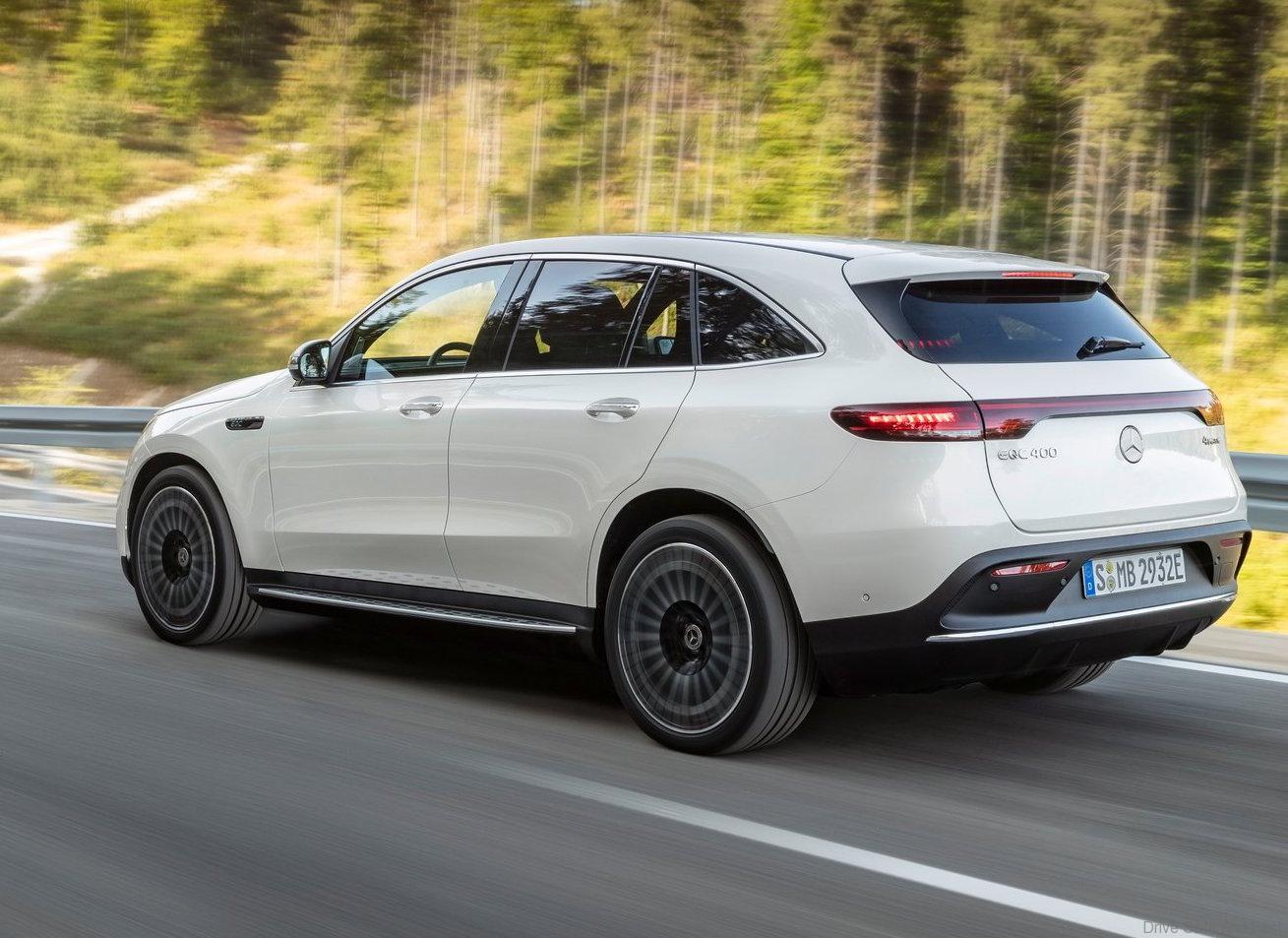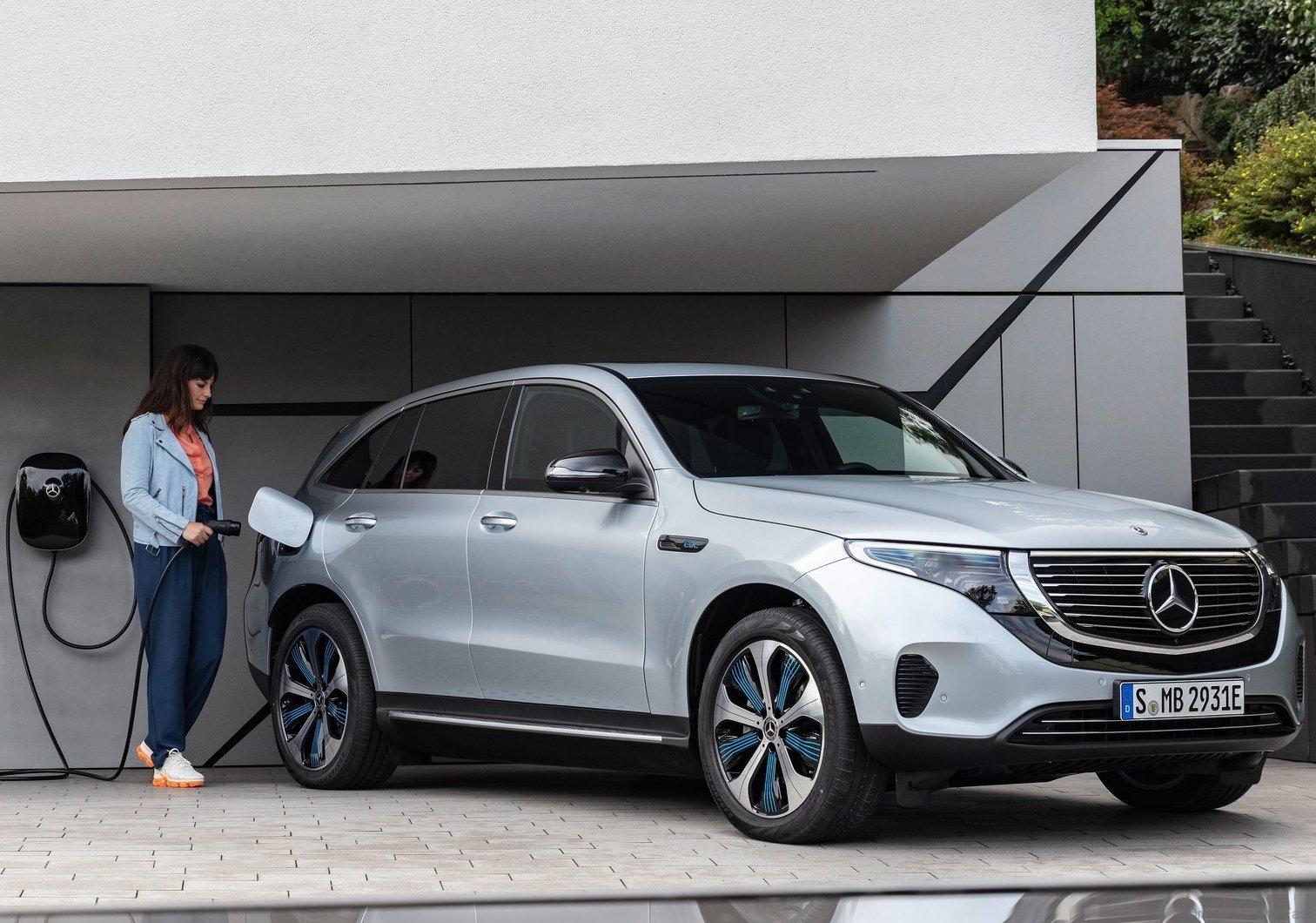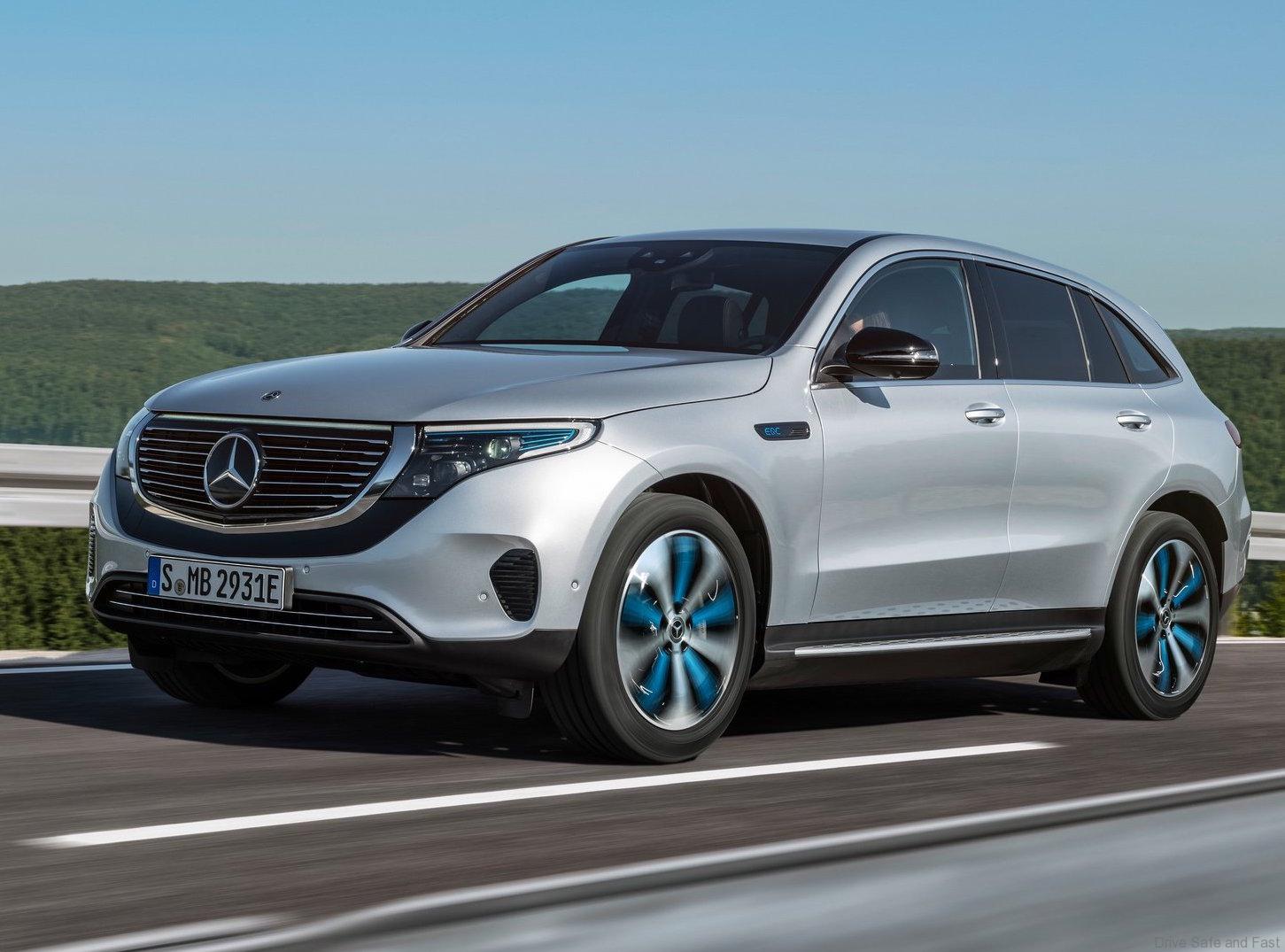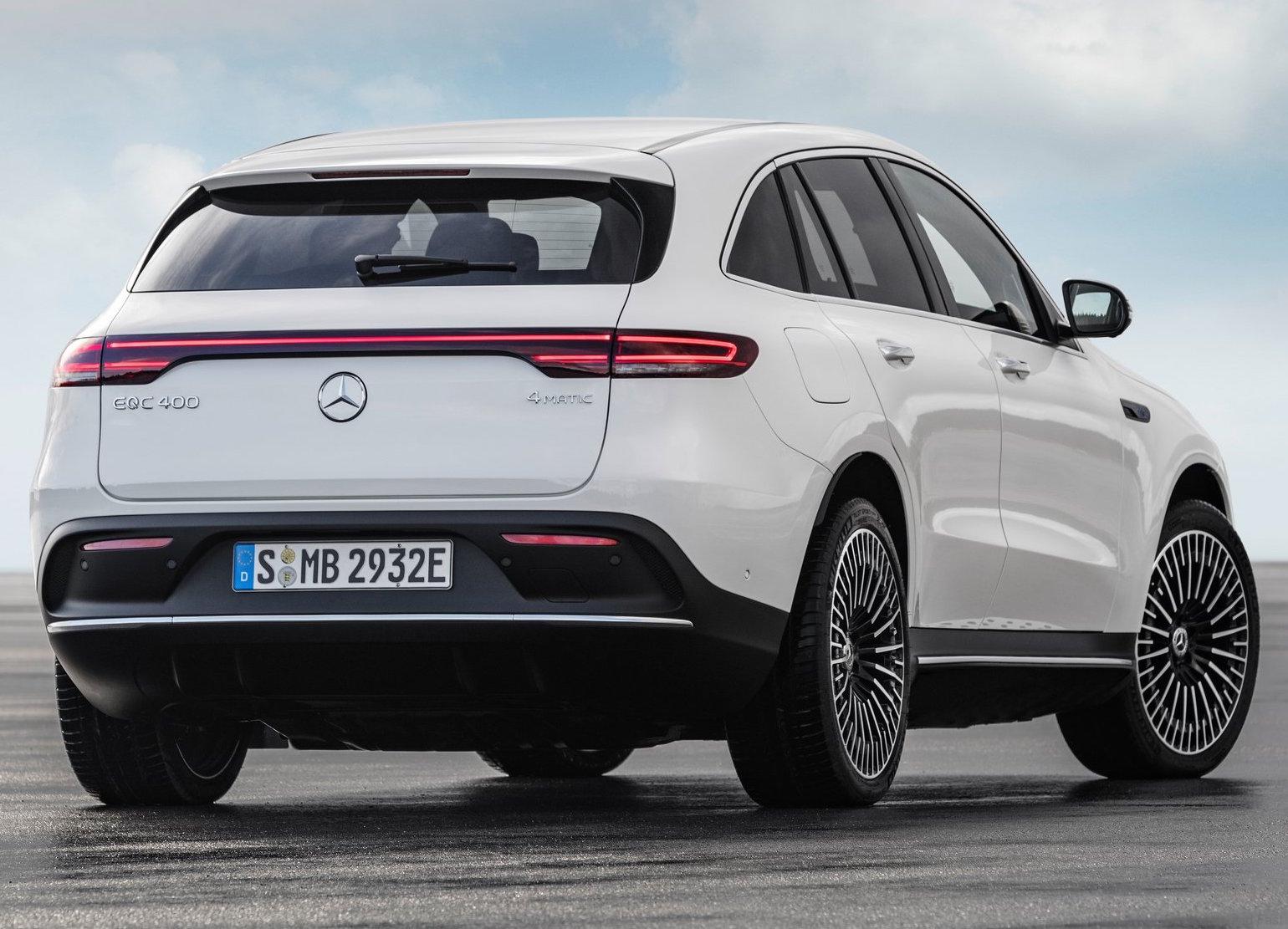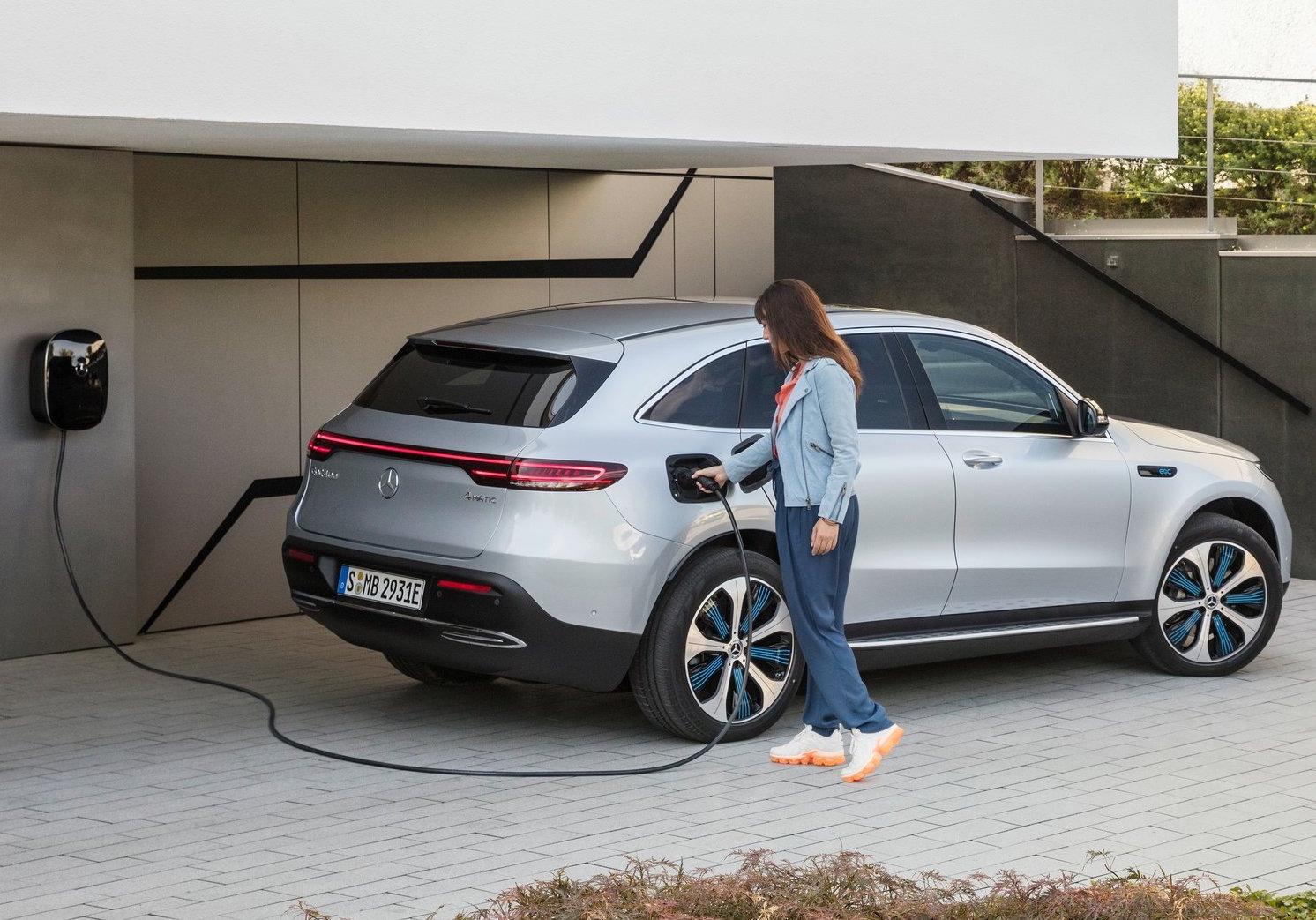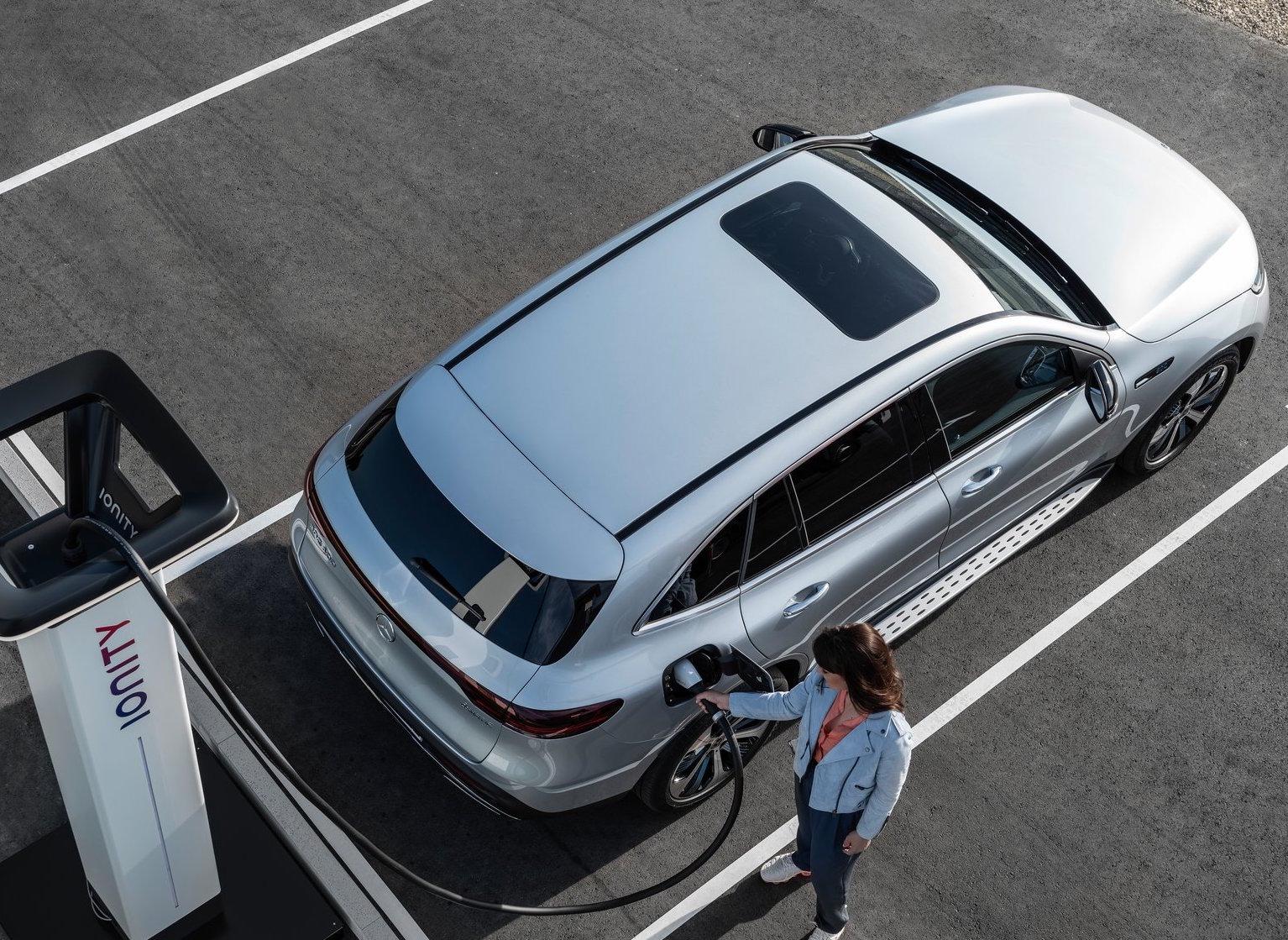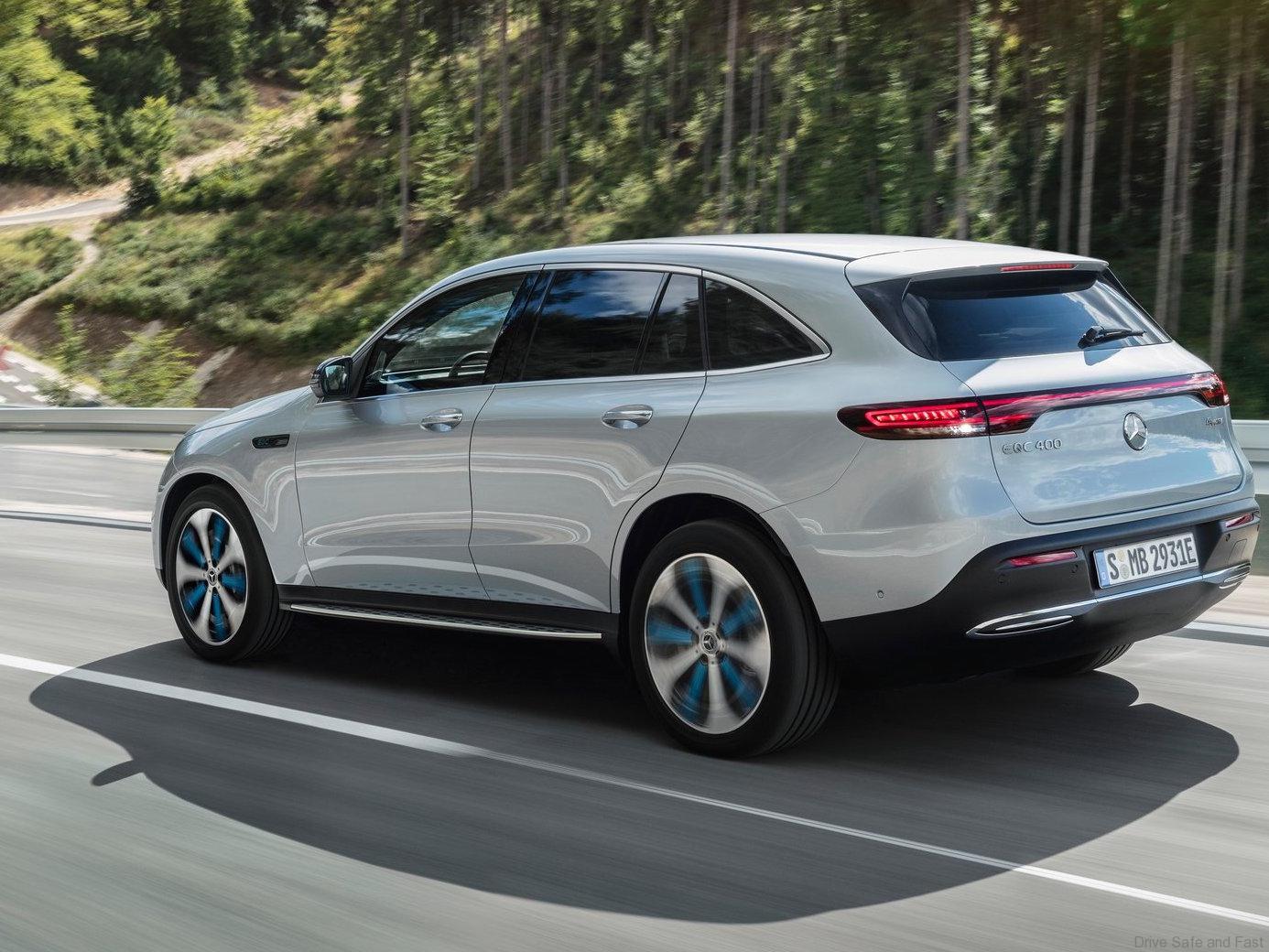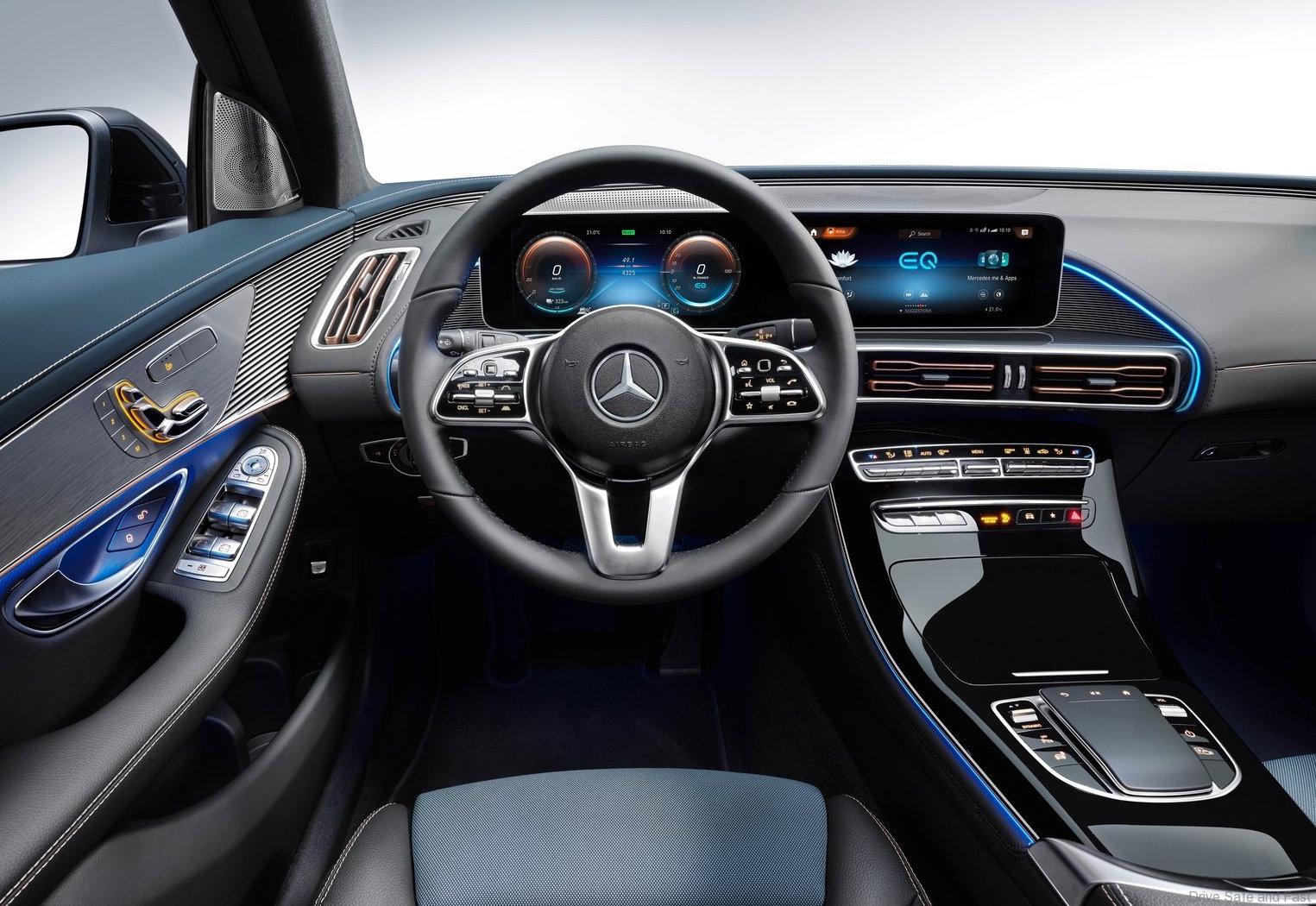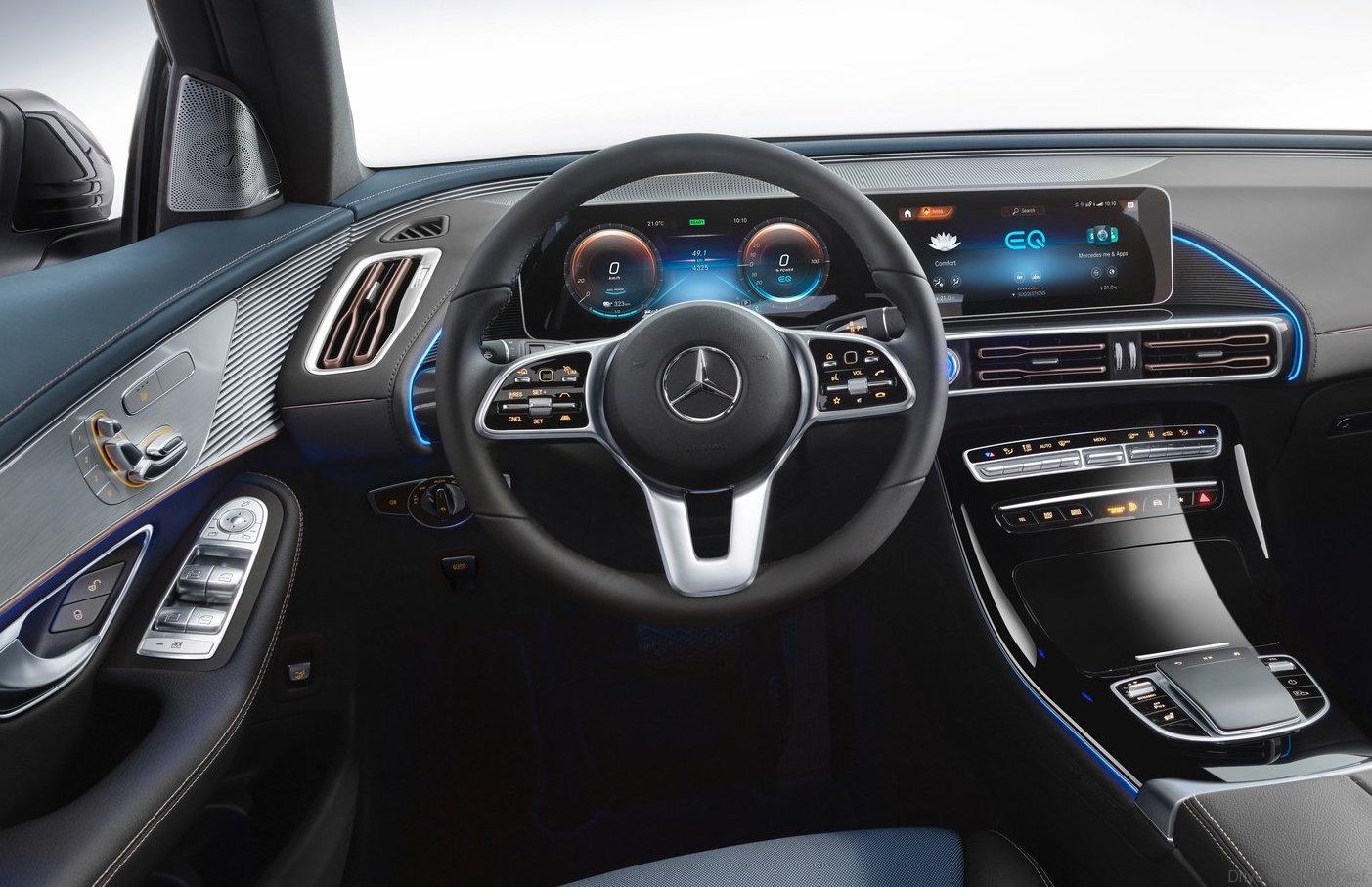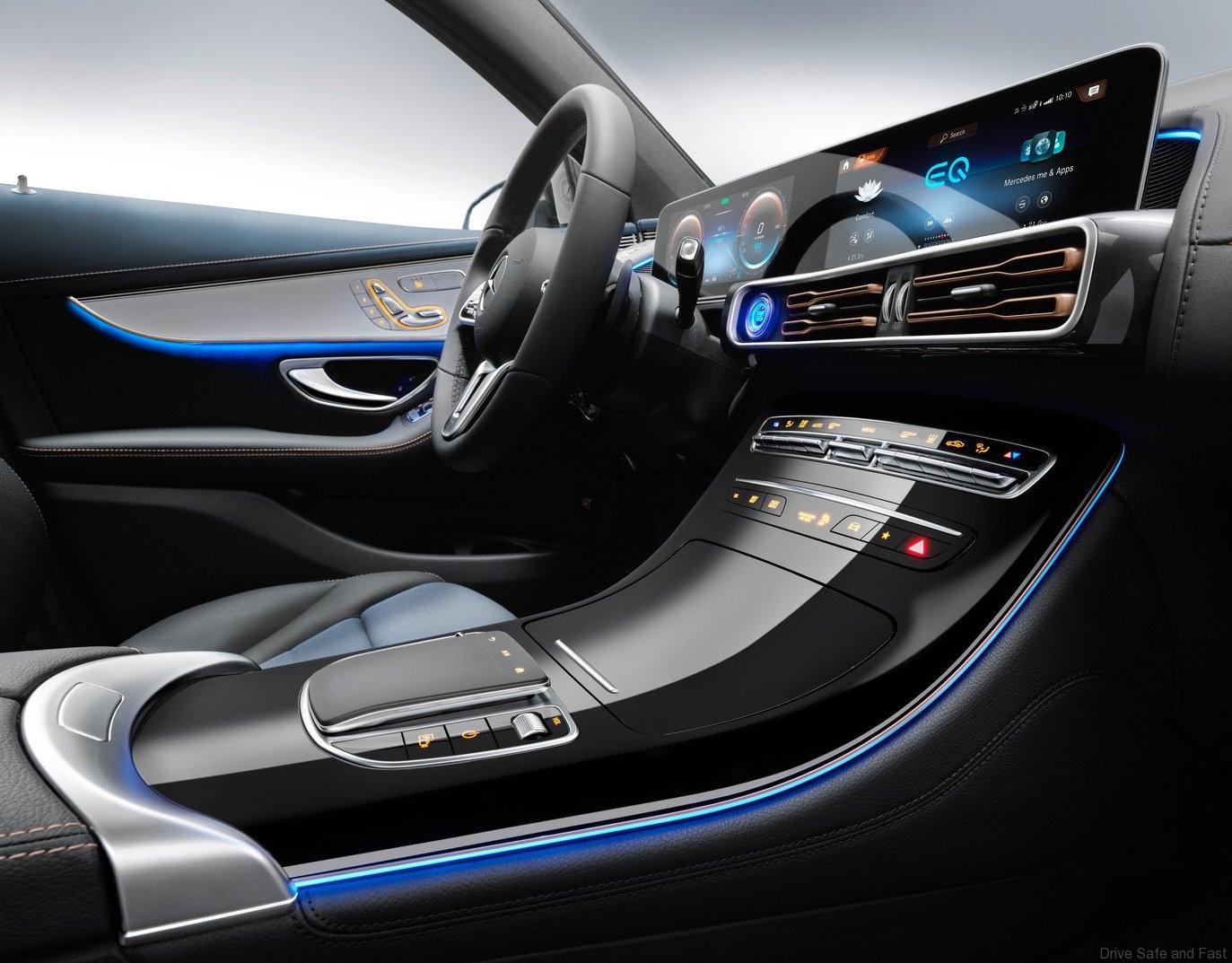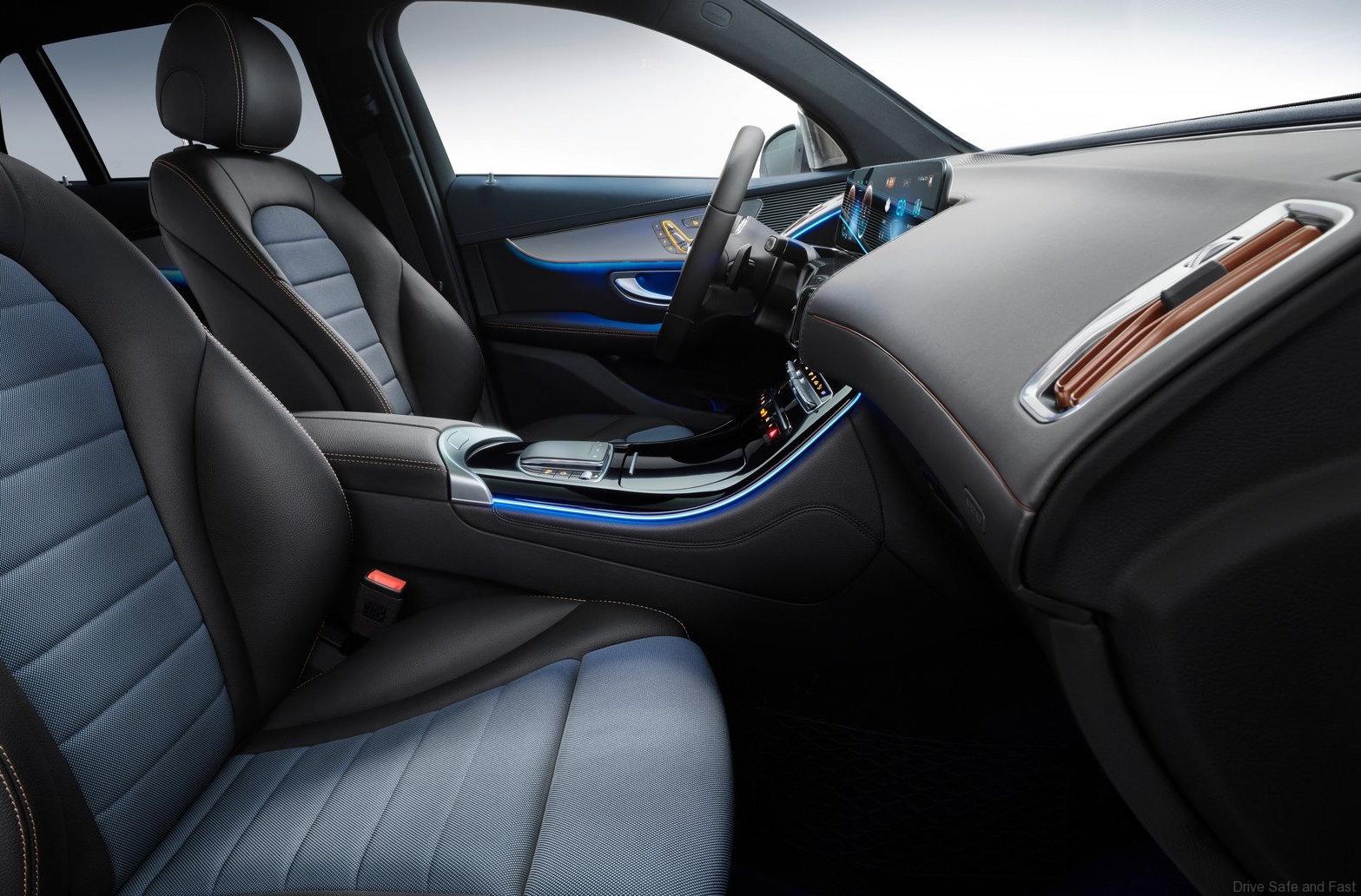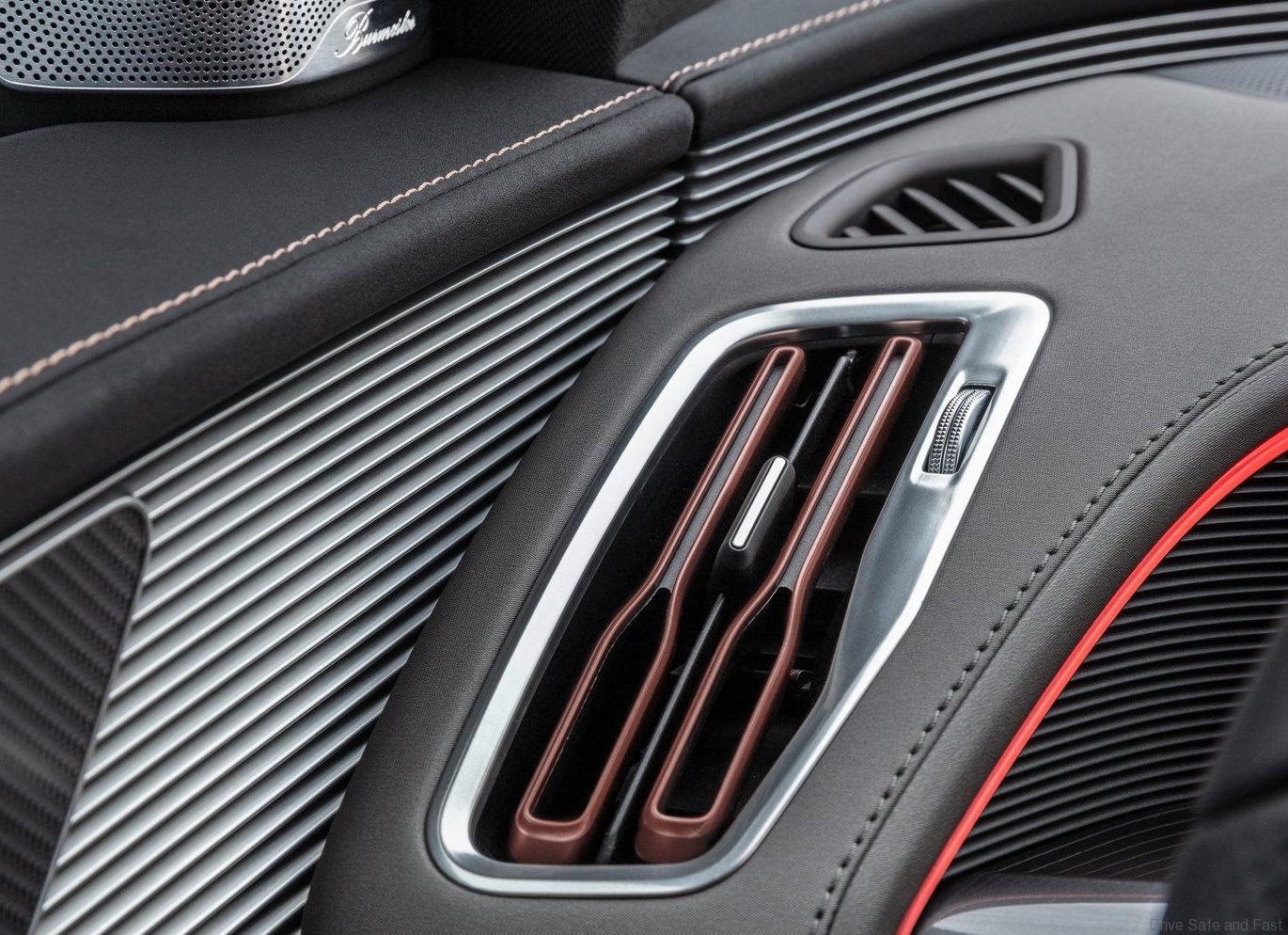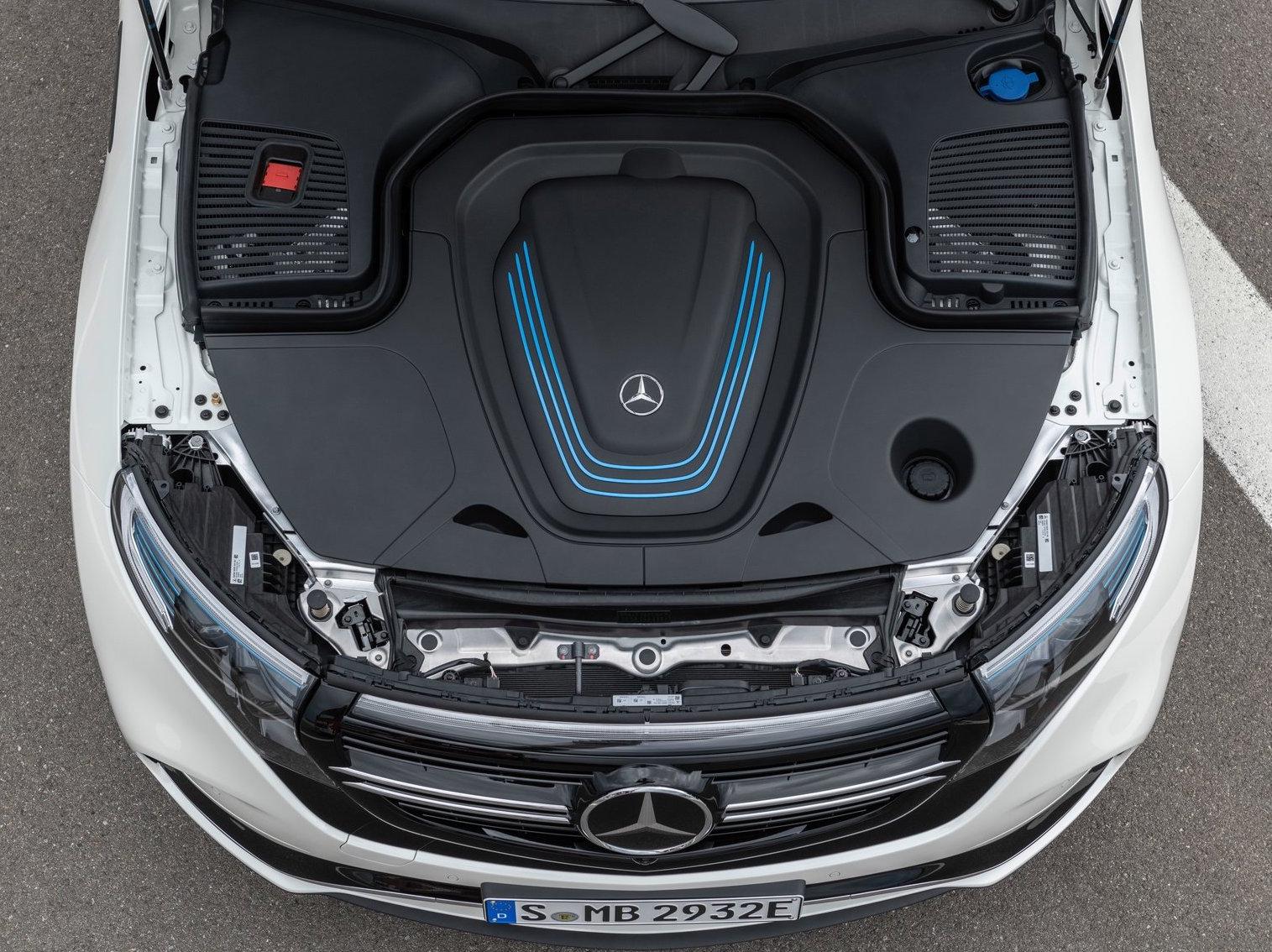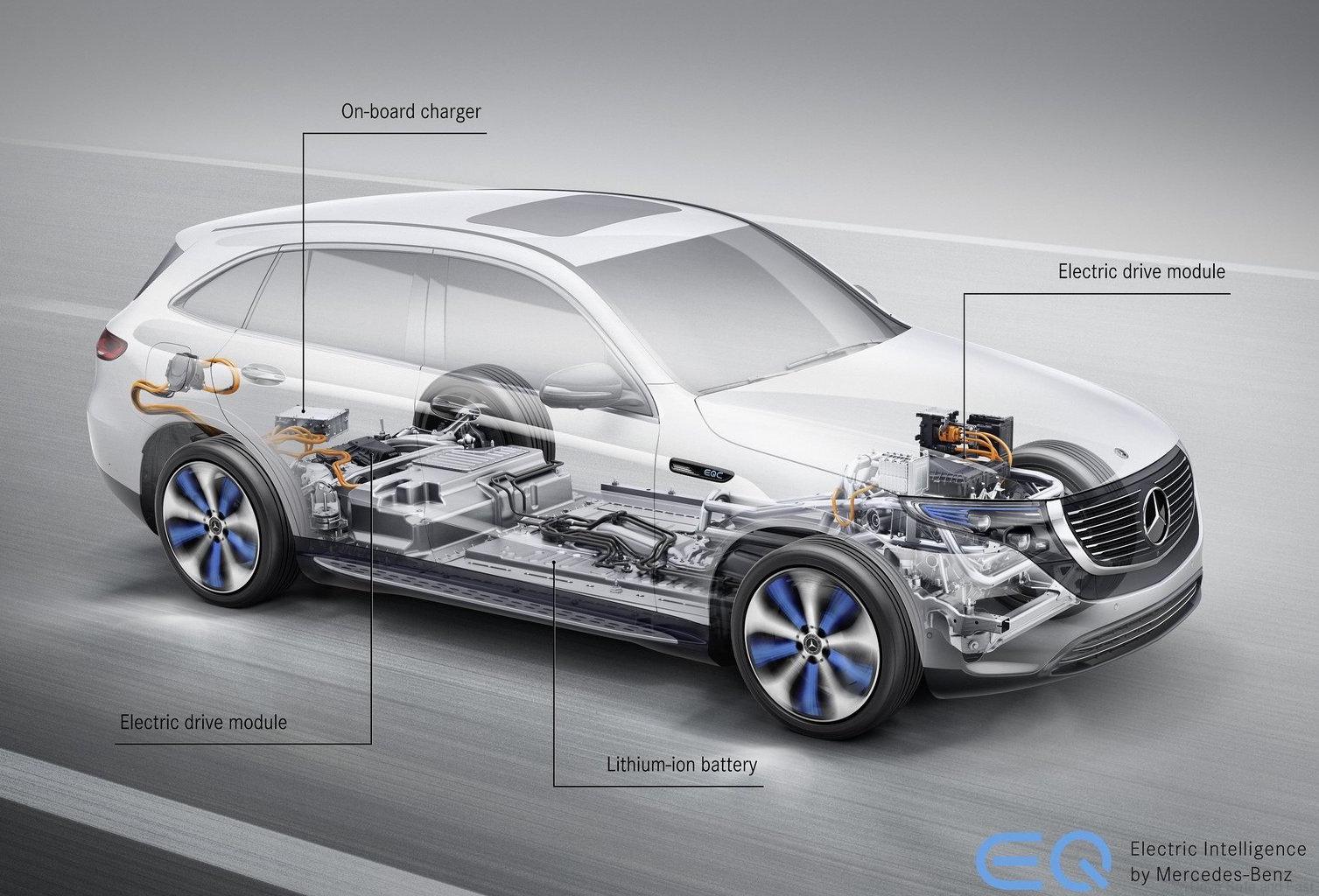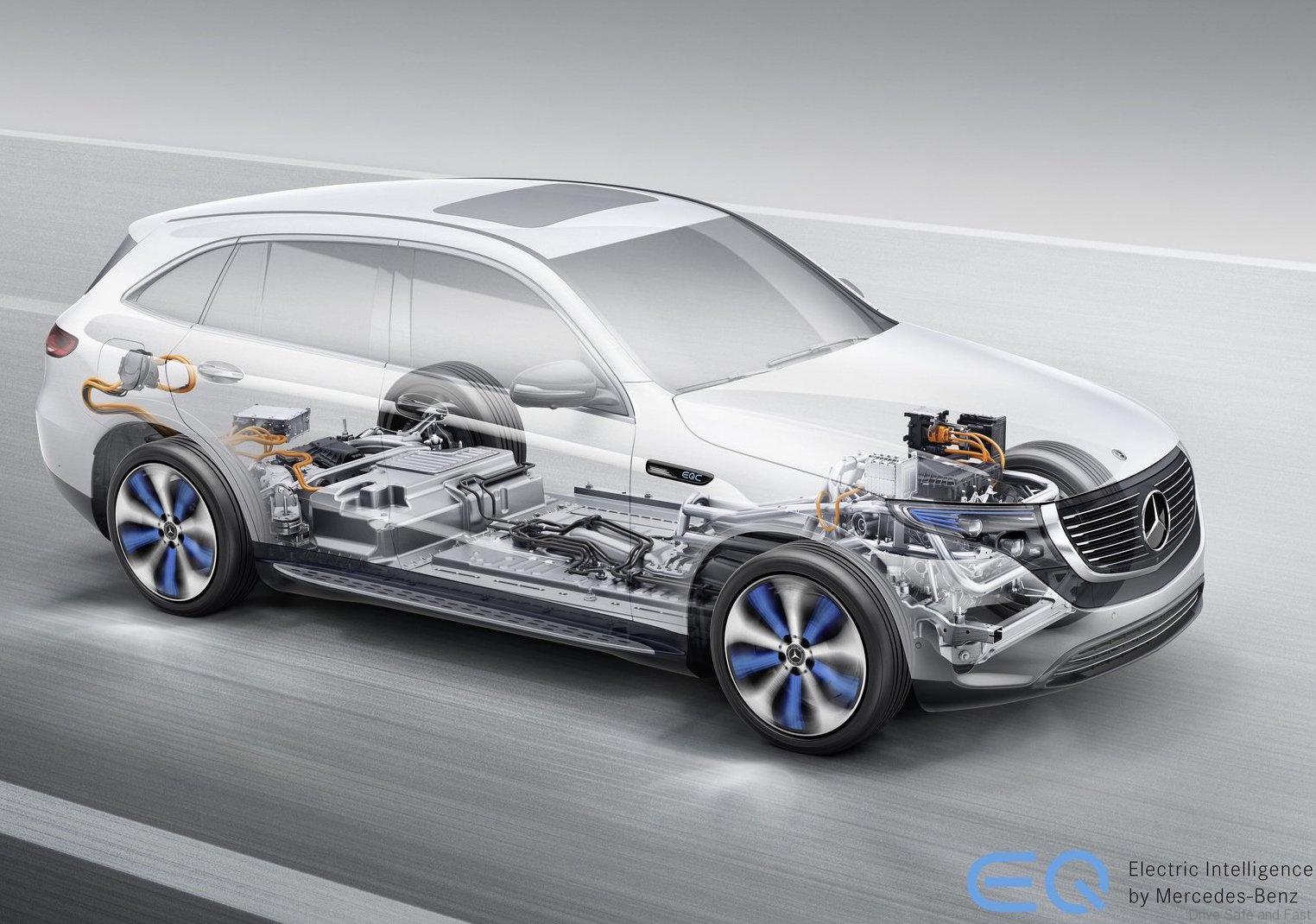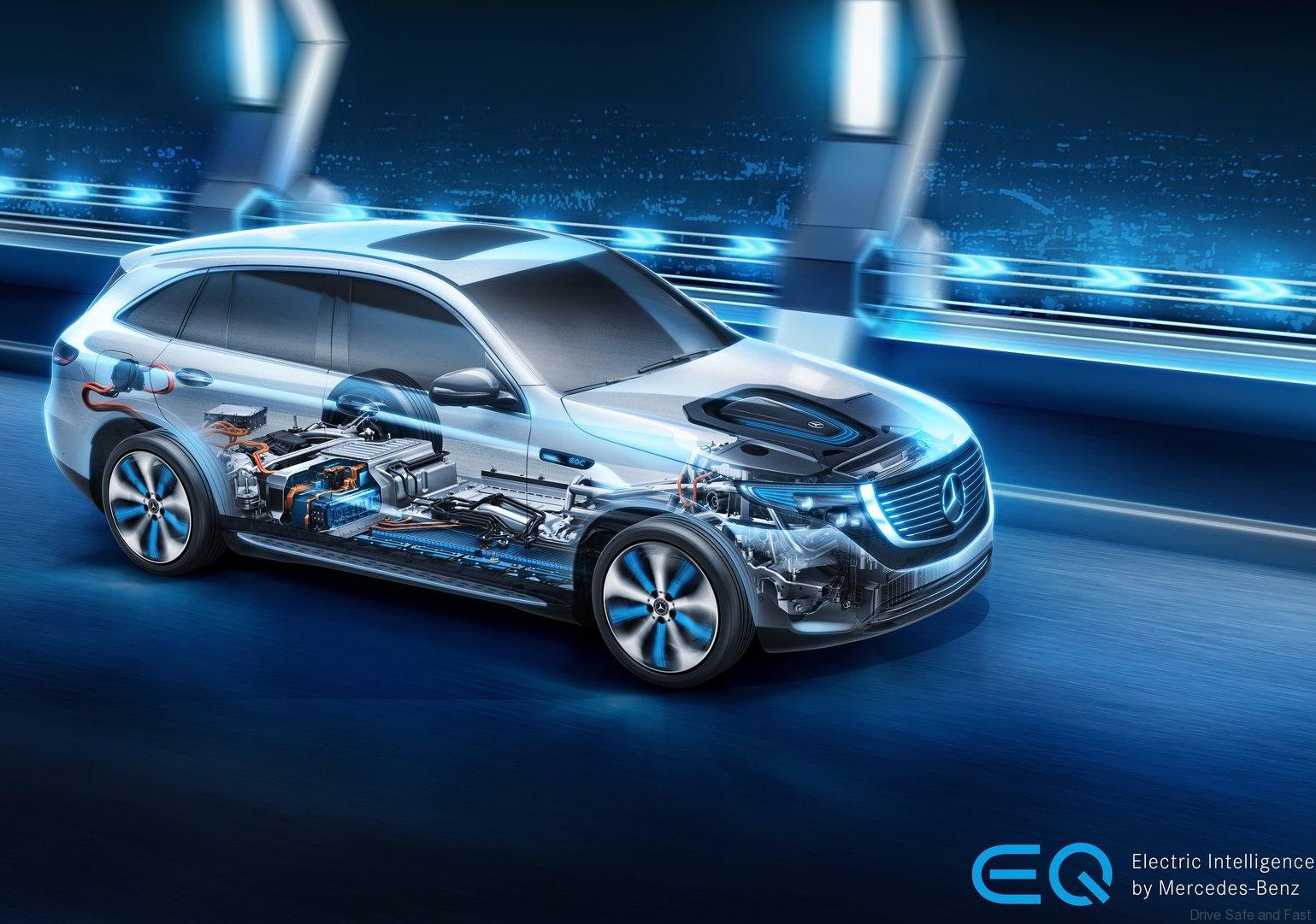The EQC is the first Mercedes-Benz vehicle to be launched under the EQ brand. The EQC is the Mercedes-Benz among electric vehicles, and highly convincing in the sum of its attributes. These are accompanied by dynamic performance, thanks to two electric motors at the front and rear axles with a combined output of 300 kW. A sophisticated operating strategy enables an electric range of more than 450 km according to NEDC. EQ also offers comprehensive services with Mercedes me, and makes electromobility convenient and suitable for day-to-day motoring. The Mercedes-Benz EQC also symbolises the start of a new mobility era at Daimler.
Powertrain: Dynamic performance meets efficiency
As the first Mercedes-Benz model to be launched under the new product and technology brand EQ, the EQC features an all-new drive system development with compact electric drivetrains at each axle. These give the EQC the driving characteristics of an all-wheel drive.
To reduce power consumption and increase dynamism, the electric drivetrains are configured differently: the front electric motor is optimised for best possible efficiency in the low to medium load range, while the rear one determines dynamism. Together, they generate an output of 300 kW and a maximum torque of 765 Nm.
Mercedes-Benz engineers have enhanced noise comfort with a number of measures. In the Mercedes-Benz EQC the powerpacks are isolated by rubber mounts at two points: where the powerpack connects to its subframe and where the subframe connects to the body. This effective isolation is supplemented with insulation measures. As a result, the interior of the EQC is extremely quiet.
The lithium-ion battery, which has an energy content of 80 kWh (NEDC) supplies the vehicle with power. The power consumption and range of electric vehicles depend very much on the driving style. The EQC supports its driver with five driving programs, each with different characteristics: COMFORT, ECO, MAX RANGE, SPORT and an individually adaptable program. In the more economical driving modes, the haptic accelerator pedal that prompts the driver to conserve power plays an important role. The driver is also able to influence the recuperation level using so-called paddles behind the steering wheel.
The ECO Assist system gives the driver comprehensive support when driving predictively: by prompting the driver when it is appropriate to come off the accelerator, e.g. because the vehicle is approaching a speed limit, and by functions such as coasting and specific control of recuperation. For this purpose, navigation data, traffic sign recognition and information from the intelligent safety assistants (radar and stereo camera) are linked and processed.
Charging: Flexible and fast
As standard the EQC is equipped with a water-cooled onboard charger (OBC) with a capacity of 7.4 kW, making it suitable for AC charging at home or at public charging stations.
Charging at a Mercedes-Benz Wallbox is up to three times faster than at a domestic power socket. It is faster still with DC charging – which is standard for the Mercedes-Benz EQC – for example via CCS (Combined Charging Systems) in Europe and the USA, CHAdeMO in Japan or GB/T in China. Depending on the SoC (status of charge), the EQC can be charged with a maximum output of up to 110 kW at an appropriate charging station. In around 40 minutes, the battery can be charged from 10 – 80 percent SoC (provisional data).
The multimedia system MBUX: with EQC-specific functions
The EQC features the innovative multimedia system MBUX – Mercedes-Benz User Experience – which has numerous EQ specific functions such as the display of range, charge status and energy flow. EQ optimised navigation, driving modes, charging current and departure time can also be controlled and set via MBUX.
The MBUX display has a special EQ tile where numerous EQ features are grouped. Alternatively the user can access the EQ menu of the MBUX system directly using a key in the lower left control panel. Thanks to natural language recognition, the EQ specific voice control helps the driver to operate the Mercedes-Benz EQC.
Intelligent services: Relaxed travel from start to finish
EQ with Mercedes me provides comprehensive services for the electromobility of today and tomorrow. The most important new services and functions of the EQC planned for market launch include:
Pre-entry climate control: This ensures that the vehicle interior is already at the desired temperature on departure. It can be programmed directly via MBUX or via the Mercedes me App. A sophisticated system with a heat pump and electric heater boosters pre-climatises the interior.
The EQ optimised navigation always bases its calculation on the fastest route taking into account the shortest charging time. The route planning also responds dynamically to changes, and can take place both offboard and onboard, i.e. externally (via the Mercedes me App) and within the vehicle. Thanks to EQ optimised navigation, Mercedes-Benz customers can easily find charging stations, and Mercedes me Charge gives them convenient access to the charging stations of numerous providers, also beyond national borders. In this case customers benefit from an integrated payment function with simple accounting.
Active and passive safety: EQC-specific safety concept
The EQC is equipped with the latest generation of Mercedes-Benz driving assistance systems. In the Driving Assistance package, these include new functions such as predictive speed adjustment when approaching the end of a tailback: when a tailback is detected, Active Distance Assist DISTRONIC reduces the speed to around 100 km/h as a precaution. In a tailback on the motorway, the lane guidance system keeps the vehicle off-centre to leave space for the emergency services.
The EQC also meets the highest requirements with respect to passive safety: in addition to the usual, extensive programme of crash tests, Mercedes-Benz applies further, particularly stringent safety standards to the battery and all component parts carrying electrical current. These standards exceed legal requirements. The vehicle structure of the Mercedes-Benz EQC has been adapted to suit the special requirements of the electrical components and battery, and is configured to achieve the usual high safety level. For example, a new subframe surrounds the drive components located in the front section, and this unit is supported by the usual mounting points.
Mechanical protection of the battery: the high-safety design begins with the installation position of the high-voltage battery beneath the vehicle floor. The energy storage unit is surrounded by a stable frame that can absorb energy. Deformation elements are installed between the frame and the battery, and these are able to absorb additional forces in the event of a severe side impact. A battery guard in the front area of the battery is able to prevent the energy storage unit from being pierced by foreign objects.
Electrical protection of the high-voltage system: the extensive experience of Mercedes-Benz with high-voltage drive systems has led to a multi-stage safety concept that deploys in the event of an accident. The high-voltage system automatically shuts down, reversibly or irreversibly, according to the severity of the accident. There are also shutdown points where emergency teams can deactivate the high-voltage system manually.
Testing: Endurance tests around the world
By market launch, 200 prototypes and pre-production vehicles of the EQC will have absolved tests covering several million kilometres across four continents (Europe, North America, Asia and Africa). The test program comprises more than 500 individual tests. Like all Mercedes-Benz vehicles, the EQC must absolve the demanding standard test programme. There are also special tests for the electric powertrain, the fuel cell, and the interplay of all powertrain components.
In the process the test experts are able to build upon the extensive findings from their digital testing work, used to ensure both the buildability of the vehicle and for the simulation of e.g. crash behaviour, aerodynamics and NVH: noise, vibration, harshness. In addition, there are intensive tests on numerous test rigs at the Mercedes-Benz Technology Centre in Sindelfingen. The ratio between digital and real testing is roughly 35 to 65 percent.
Production: Preparations in full swing in the Bremen plant
Series production of the EQC will start in 2019 at the Mercedes-Benz plant in Bremen. The preparations for this are already fully under way. The new EQC will be integrated into ongoing series production as a fully electric vehicle. The very latest production technologies will be employed.
One decisive innovation is the so-called battery-joining centre where the Mercedes-Benz EQC undergoes a second “marriage”” following installation of the two electric powerpacks in the bodyshell. This is where the EQCs are recognised as electric models with the help of data tags attached to the body, and equipped with a battery. The body is suspended from a so-called C-carrier and deposited on a frame. Support arms raise the battery to the vehicle’s floor from below. An employee monitors the automatic bolting in place.
In parallel with this, production of our own batteries for the EQC is coming on stream at the expanded battery plant in Kamenz (near Dresden).
Alongside Bremen, the Sino-German production joint venture Beijing Benz Automotive Co. Ltd. (BBAC) is also preparing for the production start-up of the EQC for the local market.
Design: Progressive Luxury: Pioneer of a new electro-look
Is the first Mercedes-Benz model launched under the new product and technology brand EQ, the EQC features pioneering design details and hallmark colour accents. As a particularly striking feature, the headlamps and air inlet blend into a black-panel surface. The high-quality interior of the Mercedes-Benz EQC also pioneers an avant-garde electro-look. The innovative interior design is inspired by the world of consumer electronics. One example is the louvred edge of the instrument panel, which resembles the cooling ribs of a hi-fi amplifier. Both inside and out, the EQC embodies the design idiom of Progressive Luxury.
The EQ brand gives an insight into the future, and is shaped by an avant-garde, distinct look – Progressive Luxury. This arises from the combination of a previously unknown beauty, the conscious clash of digital and analogue elements as well as the seamless merging of intuitive and physical design.
By virtue of its muscular proportions, the EQC is classed as a crossover SUV. The extended roofline and window layout with a low waistline and the coupé-like roof recess at the rear visually position it between an SUV and an SUV coupé.
A striking feature at the front is the large black-panel surface enclosing the headlamps and grille. The inner housings and tubes of the standard MULTIBEAM LED headlamps are in high-gloss black. Colour highlights discreetly confirm the model’s membership of the new EQ family: blue stripes on a black background, and MULTIBEAM lettering also in blue.
For the first time, the black panel is bordered at the top by an optical fibre as a visual link between the torch-like daytime running lamps as a typical Mercedes-Benz feature. At night this creates an almost uninterrupted, horizontal light band. In certain markets this unmistakable night design is supplemented with an illuminated central star. This optional extra has been combined with the radar sensor Active Distance Assist DISTRONIC for the first time, and acts as an additional position lamp for the stationary vehicle.
Other design features at the front include the air inlet with two chrome louvres in the lower area of the front apron and the simulated side air inlets in high-gloss black.
The lower section of the bumper is in black. Together with the likewise black facing of the side members and the lower section of the rear bumper, this produces a well-balanced overall effect. Moreover, this colour concept together with the low waistline visually lowers the vehicle height and ensures an off-road- look.
At the rear the sporty, stretched silhouette is finished off by a low roof spoiler. The roof contour and side window layout visually confirm that the EQC is conceived as a crossover SUV. The side windows are framed by high-gloss aluminum trip strips. The charging flap is integrated flush with the rear right side wall.
Roof rails have deliberately been omitted, preserving the clear, monolithic form and further enhancing aerodynamics. As with other Mercedes-Benz car models, robust attachment points integrated into the roof structure allow carrier systems to be mounted.
The EQC is fitted with 19 to 21-inch, aerodynamically enhanced, bicolour light-alloy wheels, which are flush with the wheel arches. Two wheel variants have blue touches on the rim flange or spokes.
The deep roof spoiler adds to the excellent aerodynamics and emphasises the width of the rear window. The transition between the bumper and tailgate is practically seamless. The multi-section rear lights with tail lights in edge-light technology echo the light band at the front. The reflectors are positioned separately in the bumper. This allows a flatter, sporty layout for the rear lights. The multi-section chrome strip in the lower area of the bumper emphasises the visual breadth of the rear end.
As in Mercedes-Benz coupés, the registration plate is in the bumper. This makes the Mercedes star in the tailgate particularly prominent. This is also used to open the tailgate, and accommodates a reversing camera if corresponding optional equipment is specified.
The model lettering Mercedes-Benz EQC is located on the left of the tailgate, and has a new, EQ specific typography. The lettering is in chrome, therefore it harmonises with all paint colours.
Interior design: Progressive design idiom, modern materials
The high-quality interior of the EQC also pioneers an avant-garde electro-look. This applies to the form, material mix and user experience. There is a unique contrast between sensuous, soft surfaces, precise edges and geometrical shapes. Anybody seeing the EQ’s design once will always recognise it again.
The instrument panel is designed as a driver-oriented cockpit. Both in volume and complexity, its upper section is reduced to what is essential. The typical Mercedes-Benz wing profile is asymmetrical, with a “cut-out” in the driver area. This is where one of the visual highlights of the cockpit is located – a high-tech, high gloss cassette housing flat air vents with key-shaped, rosé-gold coloured louvres. These are a feature of the new EQ design idiom, and are exclusive to this new model.
The instrument panel has a metal surround reminiscent of the cooling ribs found on high-quality music amplifiers. This design feature is a wrap-around extending into the doors. The simulated, metallic-look ribbed rim continues into the door panels as a design highlight, and has integral mid-range speakers. This creates a harmonious contrast between high-tech aesthetics and classic door trim. The perforated plate feature is another repeated design motif. It is found e.g. at the top of the instrument panel support and in the mirror triangles. Round depressions of different diameters create a dramatic three-dimensional pattern. If a Burmester® sound system is specified, the mirror triangle accommodates the tweeter and has the familiar metallic look with a pattern of perforations and a key signature.
The instrument cluster and media display (2 x 10.25-inch as standard) are housed behind a shared, continuous glass surface to form a large, free-standing screen. There is a touchpad in the centre console as a further means of controlling many vehicle functions. The ambience lighting impressively illuminates the instrument panel, with optical fibres coursing through the entire cockpit and across the deck with the air vents.
The EQ character of the interior is accentuated by a brand-specific colour scheme that is unique in the Mercedes-Benz portfolio. High-grade materials such as leather, plus modern trim elements in an aluminium look or with open-pore wood, convey the familiar, high Mercedes-Benz quality. This is further enhanced by innovative, newly developed surfaces. These include, for example, the finely woven “Sunnyvale” upholstery in indigo blue or beige, the slightly iridescent shade producing an elegant, high-tech sheen. In line with the environmentally friendly drive concept of the EQC, it is manufactured from high-quality recycled material. The Sunnyvale fabric lines the centre sections of the backrest and seat surface. The side bolsters are of man-made leather and have rosé-gold coloured topstitching.
A new, ultra-fine surface structure is pleasant to the touch and extends across the beltline. Also new is a futuristic, textile-like structure in metallic silver-grey. This is particularly effective in combination with the air vent deck in dark chrome. This new Progressive Luxury is further enhanced by elegant highlights in rosé-gold, e.g. on the vanes of the front air vents and in the instrument panel itself. These are produced by bending millimetre-thick real leather in rosé-gold and sewing it into the edging.
The design and equipment lines: Electric Art and AMG Line
The equipment line Electric Art has the design features described above with rosé-gold highlights. The Mercedes-Benz EQC is also available in the sporty equipment line AMG Line, with the options of AMG Line Interior and AMG Line Exterior.
The EQC with AMG Line Exterior features e.g. an AMG-specific radiator grille and mirror housings in the vehicle colour. It also looks considerably more sporty thanks to a distinctive front apron. A wide rear apron in an AMG design further reinforces this impression. Several new AMG wheel designs in sizes between 20 and 21 inches are available for the Mercedes-Benz EQC.
The interior also becomes more sporty with the AMG Line Interior. In addition to a three-spoke AMG multifunction sport steering wheel with flattened lower section, the package includes an AMG sports pedal cluster of brushed stainless steel. The seats are in black ARTICO man-made leather/microfibre, with leather seats and carbon-fibre look trim available as an option. AMG floor mats round off the AMG Line Interior.
MBUX: Intuitive control structure and different display styles
The information of the instrument cluster and media display is easily legible on the large, high-resolution screens. Showcasing elements in an emotively appealing manner underlines the comprehensibility of the control structure and impresses with brilliant pixel-perfect graphics.
Depending on mood or to suit the chosen interior, the user has a choice of three different styles:
- Modern Classic is a further development of the classic display style in an elegant and light material mix.
- Sport has a high-tech turbine look with decidedly sporty black/yellow contrasts.
- Electric Art presents its digital look in reduced form, and emotively displays the current state of the e-drive system. The visible colour changes explain and thrill in equal measure. The glass dials change from rosé-gold in Drive mode to white, and to “Electric Blue” during recuperation. The media display clearly presents functional aspects of the energy situation, e.g. the energy flow or the power consumption history.
- Powertrain: Dynamic performance meets efficiency
The EQC, the first Mercedes-Benz representative of the new product and technology brand EQ, features an all-new drive system development. The interplay between performance and dynamism in combination with a high level of efficiency and comfort was a particular focus of the developers. The EQC has a compact electric drivetrain at each axle, giving the vehicle the driving characteristics of an all-wheel drive. Over a wide operating range, the intelligent control allows dynamic torque distribution between the two driven axles, creating the conditions for high vehicle dynamics. The asynchronous motors have a combined maximum output of 300 kW. The centrepiece of the Mercedes-Benz EQC is the lithium-ion battery from in-house production housed in the vehicle floor. With an energy content of 80 kWh (NEDC), it employs a sophisticated operating strategy to supply the vehicle with power, enabling an electric range of more than 450 (according to NEDC, provisional figure).
The vehicle concept of the EQC is designed for all the requirements of a battery-electric drive system. Both the electric powertrains and the battery are tailor-made for the Mercedes-Benz EQC. Tractive power is provided by an asynchronous motor at each axle. The electric motor, a fixed-ratio transmission with a differential, the cooling system and the power electronics form a highly integrated, very compact unit. To reduce power consumption and increase dynamism, the electric drivetrains are configured differently: the front electric motor is configured for best possible efficiency in the low to medium load range, while the rear one determines dynamism. Together, they generate an output of 300 kW and a maximum torque of 765 Nm.
Maximum variability for more efficiency and stability
In both their drive and recuperation functions, the electric motors operate and function irrespective of the direction of rotation. On the overrun or when braking, the mechanical rotation is converted into electrical energy and used to charge the high-voltage battery (recuperation). In the interests of maximum driving stability and efficiency, the power requirement between the front and rear axle is regulated according to the driving situation. Torque shifting allows the torque to be distributed dynamically between the front and rear axles, ensuring that there is always a satisfying balance between power and efficiency. This gives the EQC the superior driving characteristics of an all-wheel drive.
Under low to medium load conditions, only the front electric motor is operated for efficiency reasons. Maximum recuperative deceleration is achieved by using both electric motors as alternators.
Extremely quiet thanks to sophisticated decoupling
Electric vehicles are commonly known to be almost silent – above all because they have no noisy internal combustion engine. However, maximum rotational speeds of around 13,000 rpm in the electric motors pose special challenges with respect to noise insulation. Mercedes-Benz engineers have achieved an impressive level of noise comfort. In the EQC the powerpacks are isolated by rubber mounts at two points: where the powerpack connects to its subframe and where the subframe connects to the body. This effective isolation is supplemented with insulation measures. As a result, the interior of the EQC is extremely quiet.
The battery: a “heart” from Saxony/Germany
The EQC is equipped with the latest generation of a lithium-ion (Li-Ion) battery serving as the energy source for both electric motors. The battery consists of 384 cells and is located in the vehicle floor, between the two axles. The battery system is modular in design, consisting of two modules with 48 cells each and four with 72 cells each. The powerful high-voltage battery has a maximum voltage of 408 V and a nominal capacity of 210 Ah, for an energy content of 80 kWh (according to NEDC).
The integral overall cooling concept of the Mercedes-Benz EQC, consisting of a heat pump function and two electric PTC heater boosters, not only includes the power electronics, the electric motor and the rotor, but also the battery. The entire battery system is liquid-cooled. At low temperatures a battery heater ensures outstanding performance and efficiency.
The battery is an integral part of the crash concept for the vehicle as a whole. Its low, central location also has a positive effect on the handling characteristics of the EQC.
The battery is produced in Germany, by the wholly-owned Daimler subsidiary Deutsche Accumotive in Kamenz/Saxony.
As for all other high-voltage batteries, Mercedes-Benz issues a battery certificate as a commitment to the battery performance.
Charging options: Flexible and fast charging
Whether at home via a wallbox, while shopping, at work or ultra-fast on the motorway: there are various ways to supply electric vehicles with power. Intelligently networked charging solutions focussed on the mobility needs and convenience of customers are an integral part of the new product and technology brand EQ.
As standard the EQC is equipped with a water-cooled onboard charger (OBC) with a capacity of 7.4 kW, making it suitable for AC charging at home or at public charging stations. The charging time required for a full charge depends on the available infrastructure and the country-specific vehicle equipment. Charging at a Mercedes-Benz Wallbox is much faster than at a domestic power socket.
It is faster still with DC charging – which is standard for the EQC – for example via CCS (Combined Charging Systems) in Europe and the USA, CHAdeMO in Japan or GB/T in China. This usually public quick-charging system expands the existing technical standard for AC charging of electric vehicles with the capacity for DC fast charging. Depending on the SoC (status of charge), the EQC can be charged with a maximum output of up to 110 kW at an appropriate charging station. In around 40 minutes, the battery can be charged from 10 – 80 percent SoC (provisional data).
Energy management: The link between the battery and the power consumers
High-voltage energy management (HV-EMM) provides the link between the battery and the HV components (electric motors, air conditioner compressor, heating elements, DC/DC converter to power the 12 V components).
The functions of HV-EMM include:
- Determining the usable energy remaining in the battery
- Activation and deactivation of the high-voltage components on the basis of the available energy, and with due regard for safety requirements
- Prediction of the currently available electrical output of the powertrain
- Coordination of the charging process between the battery and charging components
- Calculation of the electric operating range and consumption for EQ optimised navigation
- Driving modes: The driver has a choice of drive strategies
The power consumption and range of electric vehicles greatly depend on the driving style. The Mercedes-Benz EQC supports its driver with driving modes that have different characteristics. In the more economical driving modes, the haptic accelerator pedal that prompts the driver to conserve power plays an important role.
The following programs are available:
- COMFORT: Default setting; accelerator pedal characteristic supports a comfortable driving style, but also automatically becomes more dynamic depending on the driving style.
- ECO: Driving program focused on high efficiency and low consumption.
- MAX RANGE: Intelligent driving program that can help the driver achieve the maximum possible range.
- SPORT: Driving program focused on the best response for the highest driving performance.
- INDIVIDUAL: There is also an individual driving program which allows the various parameters to be adjusted separately.
- One-pedal driving: manual selection of braking recuperation
The driver is also able to influence the recuperation level using so-called paddles behind the steering wheel. The paddle on the left increases the level of recuperation, the paddle on the right reduces it. The following stages are available:
- D Auto (recuperation via ECO Assist to suit the situation)
- D + (coasting)
- D (low recuperation)
- D – (medium recuperation)
- D – – (high recuperation). This makes one-pedal driving possible, because in most situations the recuperative deceleration is enough not to require operation of the brake pedal.
ECO Assist: Intelligent efficiency through the use of sensor fusion
- Predictive driving for economy – the ECO Assist assistance system comprehensively supports drivers in implementing this effective efficiency strategy: by prompting the driver when it is appropriate to come off the accelerator, e.g. because the vehicle is approaching a speed limit, and by functions such as coasting and specific control of recuperation. For this purpose, navigation data, traffic sign recognition and information from the intelligent safety assistants (radar and stereo camera) are linked and processed.
- ECO Assist takes the following traffic situations and information into account in its driving recommendations and efficiency strategy:
- Route profile (bends, junctions, roundabouts, gradients)
- Speed limits
- Distance from vehicles travelling ahead
- ECO Assist continuously generates coasting simulations in the background: depending on the traffic situation, it computes whether the vehicle should ideally be allowed to coast with the lowest possible driving resistance with the driver’s foot off the accelerator, or whether it should be decelerated so that the battery can be efficiently charged (recuperation).
- Within the limits of the system, ECO Assist controls the overrun according to the situation as soon as the driver’s foot leaves the accelerator. The driver is given a discreet prompt to do this by a “foot off accelerator” symbol in the media display (or, if installed, in the head-up display). At the same time, a diagram gives the driver the reason for the recommendation (e.g. “Junction ahead” or “Gradient ahead”).
- ECO Assist predictively computes the driving situation when deciding whether to drive with the lowest resistance or whether to recuperate. Examples include dips, brows or speed limits ahead, which the system recognises from the map data.
- Dip: the vehicle recognises that a downhill gradient is followed by a climb, and that a speed limit is shown. The driver receives the prompt “Foot off accelerator” in good time. As soon as the driver acts on this, the vehicle continues with the drive switched off. Recuperation takes place on the downhill stretch, but only enough to ensure that the maximum permitted speed is maintained. Recuperation ends just before the lowest point in the dip, and coasting commences to maintain as much impetus as possible for the uphill stretch in the interests of energy efficiency.
- Brow: There is a speed limit of 90 km/h before the brow of a hill, and afterwards 100 km/h. Once again the driver is prompted with “Foot off accelerator” before the brow is reached, followed by coasting when the driver complies. On the following downhill stretch, the new target speed of 100 km/h can be reached by coasting and maintained by recuperation.
- Speed limit: When the system recognises a speed limit from the navigation data or via Traffic Sign Assist, the driver is once again prompted with “Foot off accelerator pedal”. The vehicle is then gently decelerated (while recuperating) to the new speed, followed by coasting. In this way suitable speeds for junctions, roundabouts and bends are also supported.
- Slow-moving traffic: when the radar sensors of the system recognise slow-moving vehicles ahead while coasting, coasting is automatically interrupted if necessary. Deceleration with recuperation takes place to the extent that braking action by the driver is often unnecessary. If the vehicle ahead accelerates, coasting is reactivated automatically so as to cease deceleration and maintain the current speed as much as possible. The driver operates the accelerator if needed.
- Climate control: Pleasantly climatised interior from the start
Cars with combustion engines use their waste heat to warm the interior. Electric vehicles are more efficient – which means lower energy losses but also less waste heat to warm the interior. In other words, the engineers needed new, intelligent concepts.
A sophisticated system with a heat pump and electric heater boosters pre-climatises the interior, ideally when charging. This increases range, as the energy requirement from the high-voltage battery can be greatly reduced. The EQC also uses the waste heat from the battery as an energy source. The integrated overall cooling concept, which cools both the power electronics and the rotors of the electric motors, is also designed for efficiency.
Thanks to pre-entry climate control, EQC drivers neither need to scrape windows nor get into ice-cold cars. And even in hot summer temperatures, the interior is cooled to a pleasant level before starting a journey. Pre-entry climate control can be controlled via the multimedia system MBUX – Mercedes-Benz User Experience – or conveniently from the home or office using the Mercedes me App.
Pre-entry climate control uses target values as a basis. In other words, when the driver inputs a departure time, the EQC is climatised to the set temperature by that time. The driver can do this either individually for each journey and every stretch of the journey, or with the help of a weekly profile. Pre-entry climate control is also activated automatically for five minutes as soon as the vehicle is unlocked using the key. When the maximum one-hour pre-entry climate control pre-programmed via the Mercedes me App or MBUX is started or ended, the driver receives a push notification and is always fully informed.
In addition to automatic air conditioning, pre-entry climate control includes heating of the exterior mirrors and rear window, as well as the seat heating for the driver and front passenger.
Sophisticated control technology: how climatic comfort comes about
In the winter, many electric vehicles either fail to achieve the climatic comfort of conventional cars or their range is significantly reduced because the battery power is also used to heat the interior. Furthermore, the operating temperature of the high-battery should be kept within a certain range in the interests of battery operating life, which means that it must be cooled or heated as necessary.
In the EQC Mercedes-Benz uses a sophisticated system with a heat pump function and two electric PTC (Positive Temperature Coefficient Thermistor) heater boosters. A heat pump – also familiar from domestic appliances – operates on the same principle as a refrigerator, transporting heat from a lower to a higher temperature level. This means that “cold thermal energy”, which occurs particularly frequently in electric vehicles, can be used to heat the interior.
The PTC heater boosters are in principle immersion heaters whose performance is however dependent on the inflow temperature of the coolant. The advantage is that the component itself prevents overheating, making additional protection unnecessary. This is because at low temperatures, the ceramic PTC components have a very low electrical resistance and allow a high flow of current for a good heating output. The effect is reversed if the temperature rises, however: The electric current is reduced by the increasing resistance of the ceramic blocks, therefore the system releases less heat. The two PTC heater boosters in the EQC are located in the right and left wheel arches.
For the best possible climate control compromise between efficiency and comfort (both in terms of interior temperature and air humidity), the influencing factors of battery temperature, outside temperature, humidity and dewpoint are registered and evaluated. Operation of the heat pump improves efficiency over a wide outside temperature range.
Other new features in the EQC are the water-cooled condenser and regulation of the chiller (evaporator) by an electric expansion valve. This allows more usable performance, and this can be better managed. As a result the temperature at the evaporator does not suddenly change when the chiller is required to increase its performance.
The water-cooled condenser feeds the heat from the refrigeration circuit into the heating circuit. It also ensures that the heat from the supply air and recirculated air, the waste heat of the compressor and the waste heat of the battery are available to heat the interior. In the ideal case these heat sources are sufficient to heat the interior energy-efficiently with the heat pump down to outside temperatures below 0°C without having to activate the PTC heater booster.
Active safety: High stress-relieving comfort and better support in hazardous situations
The Mercedes-Benz EQC is equipped with the latest-generation of Mercedes-Benz driving assistance systems, which provide cooperative support for drivers. In the Driving Assistance package, these include new functions such as predictive speed adjustment when approaching the end of a tailback: when a tailback is detected, Active Distance Assist DISTRONIC reduces the speed to around 100 km/h as a precaution. In the tailback itself, the lane guidance system keeps the vehicle off-centre to leave space for the emergency services.
Not only high-mileage drivers are familiar with this tricky situation on motorways: on rounding a bend, the end of a traffic tailback suddenly appears. This is where the EQC assists its driver – by recognising a tailback at an early stage and responding to it.
If Active Distance Assist DISTRONIC with route-based speed adaptation is activated, the EQC is able to recognise and respond to tailbacks or slow-moving traffic before the driver becomes aware of the hazard. When a tailback is recognised (and if the driver does not choose a different response), DISTRONIC reduces the speed to around 100 km/h as a precaution. This can significantly reduce the risk of approaching the end of an unexpected tailback at high speed.
When driving in tailbacks, the rescue lane function becomes active: When a tailback is recognised on a motorway, the speed is below 60 km/h and lane markings are recognised, the vehicle is guided along the outer lane marking without crossing it. If no lane markings are recognised, the EQC takes its lead from the vehicle ahead.
Following vehicles in a tailback: in stop-and-go traffic on motorways and similar roads, stops of up to 30 seconds are possible within which the EQC can automatically move off and follow the traffic ahead.
Once the tailback dissolves, the EQC accelerates back up to the speed preset for Active Distance Assist DISTRONIC with route-based speed adaptation. If the driver has not set a specific speed, this is the recommended motorway speed of 130 km/h in the case of Germany, and it can be individually adapted for the current motorway journey. If traffic signs differ from this, the signposted speed limit is given priority.
Within the entire speed range of the EQC and on all types of road – motorway, country road or in urban areas – the system is not only able to automatically maintain the correct distance from the vehicle ahead, but also to give the driver noticeable steering assistance, even on bends. At speeds up to 130 km/h the system is not necessarily dependent on clearly visible lane markings, as it can also steer actively, as if in a swarm, if the lines on the road are unclear, as is often the case at road works, or even if there are no lines on the road at all. The system therefore makes driving much easier, especially in bumper-to-bumper driving or tailbacks.
Active Brake Assist in the Driving Assistance package has now been supplemented with a turn-off function: If there is a risk of collision with an oncoming vehicle when turning off, the EQC can be braked within the speed range that is typical of such driving manoeuvres. Braking intervention takes place if the driver signals the intention to turn off (indicators) and the vehicle can be braked to a stop before crossing the detected lane marking. Oncoming vehicles are recognised by the long-range radar sensor at the front and the stereo multipurpose camera.
Even in the base model, Active Brake Assist has extensive safety functions:
- a distance warning from a warning lamp in the instrument cluster, if the distance from a vehicle in front is insufficient
- an additional acoustic warning if the danger of collision is identified
- braking assistance appropriate to the given situation as soon as the driver applies the brakes
- autonomous emergency braking for moving, stationary or crossing vehicles ahead if the driver fails to respond
- autonomous emergency braking also for stationary or crossing pedestrians/cyclists.
- With the Driving Assistance package, the Mercedes-Benz EQC has further driving assistance systems with functions familiar from the S-Class for route-based driver support. These include further functions of Active Brake Assist, e.g. when there is a risk of collision with crossing traffic or the end of a tailback, as well as Evasive Steering Assist and PRE-SAFE® PLUS if a collision threatens from the rear. The EQC also offers the exit warning function of Blind Spot Assist if a car or cycle is detected approaching from the rear after the EQC has stopped.
PRE-SAFE®: preventive occupant protection
Mercedes-Benz is the pioneer in reversible, preventive occupant protection. These are measures that can help mitigate the consequences of accidents. With the help of various sensors and information from ESP® or the assistance systems, the PRE-SAFE® system is able to recognise critical driving situations in advance and initiate preventive occupant protection measures if an accident threatens. These include e.g. reversible belt tensioning, automatic closing of open side windows and the sliding sunroof, and movement of the front passenger seat backrest to a more favourable crash position.
PRE-SAFE® PLUS can recognise an imminent rear-end collision and warn following traffic by flashing the rear hazard warning lights at a high frequency. If the danger of a collision persists, the system can also firmly apply the brakes of the stationary vehicle, reducing the risk of whiplash injuries by reducing the forward jolt caused by an impact from the rear. This can also reduce the danger of secondary collisions, e.g. with pedestrians or vehicles ahead at road junctions. Immediately before impact, the PRE-SAFE® anticipatory occupant protection measures are deployed.
Passive safety: Mitigating the consequences of accidents with modern technology and the EQC-specific safety concept
When it comes to passive safety too, the EQC meets the highest of demands: in addition to the usual, extensive programme of crash tests, Mercedes-Benz applies further, particularly stringent safety standards to the battery and all component parts carrying electrical current.
Daimler applies extremely high safety standards to all its models. This is true for both vehicles with a conventional internal combustion engine and those with an alternative drive. This means that, in many cases, internal Mercedes-Benz safety standards exceed legal requirements. Especially the crash-related requirements are aligned to the so-called Real Life Safety philosophy. These take findings from in-house accident research into account in the development specifications, e.g. the roof drop test. Alongside verification of crash behaviour, all Mercedes-Benz vehicles undergo additional component tests at system level.
The vehicle structure of the EQC allows for the special requirements of the electrical components and battery and is configured to achieve the hallmark high safety level. For example, a new subframe surrounds the drive components located in the front section, and this unit is supported by the usual mounting points. As the battery is housed in the vehicle floor, the EQC also has a low centre of gravity. This reduces the risk of a rollover.
Crash gaps are integrated between the wings and the doors, and like the robust door handles they make it easier to open the doors after a frontal collision.
The high-voltage system: cut-off facilities in the event of a crash
The extensive experience of Mercedes-Benz with high-voltage drive systems has led to a multi-stage safety concept that deploys in the event of an accident.
Firstly, thanks to the specific design features of the Mercedes-Benz EQC, the likelihood of an external short circuit caused by an accident is considerably reduced. The battery is surrounded by a robust frame with an integral crash structure. Deformation elements are installed between the frame and the battery, and these are able to absorb additional forces in the event of a severe side impact. A battery protection shield in the front area of the battery is able to prevent the energy storage unit from being pierced by foreign objects.
The high-voltage system can also be shut down automatically in a crash, depending on its severity. A distinction is made between a reversible and an irreversible cut-off. In the case of a reversible cut-off, which occurs in less severe accidents, it is possible to switch the high-voltage system back on if a prior insulation measurement detects no faults. This means that vehicles still capable of being driven can continue their journey. Only in the case of very severe accidents, where the vehicle is anyway usually incapable of being driven, is the high-voltage system shut down irreversibly and unable to be activated without a repair. When shutting down, there is a provision to ensure that within a few seconds there is no residual voltage in the high-voltage system outside the battery that could cause injury.
There are also shutdown points where emergency teams can deactivate the high-voltage system manually. The cut-off switch is located in the engine compartment. In addition there is an alternative shutdown point in the form of a marked cable loop as a cutting point in the fuse box on the driver’s side of the cockpit. This is intended for use by the emergency services if they are unable to reach the shutdown switch in the motor compartment.
Another feature of the comprehensive high-voltage safety concept is that the charging process is automatically stopped if an impact is detected when stationary at a quick-charging station (DC charging). During a charging process, the vehicle’s onboard electrical system and therefore the airbag control unit is usually switched off. So that the charging process is nonetheless ended during a possible impact when quick-charging the vehicle at a DC station, an additional impact sensor system is integrated into the DC box. If it detects a collision with the vehicle, the charging process is automatically stopped.
The battery: multi-stage protection concept for normal operation
The battery itself also features its own multi-stage safety system for day-to-day operation. This includes e.g. monitoring the temperature, voltage and insulation. In normal operation, if a fault is detected here, it can lead to the battery being shut down. A continuously self-monitoring safety system prevents overheating and overloading in different operating states.
Restraint systems: Belts and airbags
In addition to the structural safety and the battery protection concept, the model’s specially adapted restraint systems are particularly important for the occupants in the event of an accident. Three-point seat belts with pyrotechnical belt tensioners and belt force limiters are installed for the driver, front passenger and passengers on the outer rear seats. The centre seat of the second row is equipped with a standard three-point belt system. A rear seat belt status display informs the driver whether the passengers in the rear have fastened their seat belts. The seat belt reminder prompts front seat occupants to fasten their seat belts.
i-Size (Europe) and ISOFIX (remaining countries) child seat anchorage points on the outer rear seats ensure safe attachment of appropriate child seats with additional anchorage points at the top of the rear seat backrest (so-called top-tether anchoring). If the front passenger seat is unoccupied or a rear-facing child seat is detected, the “automatic front passenger airbag deactivation” automatically disables the front passenger airbag. This prevents infants from being injured by the deploying front passenger airbag. The reliable recognition function uses a pressure sensor.
In addition, a host of airbags provides occupant protection in an accident. These include:
- A windowbag in the roof area between the A, B and C-pillars for the head area of the driver, front passenger and passengers on the outer rear seats. These airbags can be deployed on a situational basis, e.g. during a severe lateral impact, when a rollover is detected or in various frontal collisions with strong lateral acceleration components.
- Combined thorax/pelvis sidebags for the driver and front passenger, which are able to provide additional protection in the event of a side impact. Side impact airbags for the outer rear seats are available as an option.
- Airbags for the driver and front passenger for a frontal collision, with two-stage staggered deployment on the front passenger side, depending on the detected severity of the frontal collision.
- Knee airbag for the driver to protect the knees in a severe frontal collision and stabilise the upper body, which positively influences occupant movement.
- Numerous measures help to ensure that when Mercedes-Benz vehicles suffer an accident, consequential damage is reduced and rescue of the occupants is assisted. As soon as a protective system (e.g. belt tensioner and airbag) is triggered, an emergency call or a service call is made, or a breakdown is detected, the following measures can be initiated depending on the accident type and severity:
- Automatic activation of Mercedes-Benz emergency call to notify emergency services of the location and emergency situation and initiate rescue. Data transfer is via a communication module with its own SIM card.
- Shutdown of the high-voltage system
- Activation of the hazard warning system to secure the scene of the accident and protect occupants from a follow-on accident.
- Activation of the interior lighting to help occupants and rescue services find their bearings.
- Lowering of the front side windows in the event of airbag deployment – serves to ventilate the interior and helps occupants to find their bearings.
- Opening of the central locking system to facilitate access to the interior for helpers.
- Raising of the electrically adjustable steering column; facilitates exiting and access to the driver.
- Sending a recognised breakdown or accident situation to the Car-to-X communication and to the Mercedes-Benz Service Centre (Mercedes me or Service Call) to give a warning of an accident or broken-down vehicle, and to offer the driver automatic contact with the Mercedes-Benz Service Centre.



